
- Windows 10 - Home
- Windows 10 - Overview
- Windows 10 - Installation
- Windows 10 - Getting Started
- Windows 10 - GUI Basics
- Windows 10 - Navigation
- Windows 10 - Start Menu
- Windows 10 - Taskbar
- Windows 10 - Tablet Mode
- Windows 10 - File Explorer
- Windows 10 - Cortana
- Windows 10 - Notifications
- Windows 10 - Quick Actions
- Windows 10 - Cloud
- Windows 10 - Universal Apps
- Windows 10 - Multiple Desktops
- Windows 10 - Users Management
- Windows 10 - Security
- Windows 10 - Parental Control
- Windows 10 - Applications
- Windows 10 - Web Browsing
- Windows 10 - Networking
- Windows 10 - Virtualization
- Windows 10 - Remote Access
- Windows 10 - Backup and Recovery
- Windows 10 - Project Spartan
- Windows 10 - Apps Management
- Windows 10 - Email Management
- Windows 10 - Keyboard Shortcuts
- Windows 10 - System Tray
- Windows 10 - Media Management
- Windows 10 - Favorite Settings
- Windows 10 - Shortcuts
- Windows 10 - Phones
Windows 10 - Quick Guide
Windows 10 - Overview
Windows 10 is the most recent version of the operating system from Microsoft. Officially it was released in 2015 and was initially offered free of charge to legitimate users of Windows 7 and Windows 8.1. This new version combines features from those two previous installments to suit the users in a better way for both desktop/laptop computers as well as mobile devices.

The most notable change in Windows 10 is that Microsoft replaced the Start screen tiles from Windows 8, and brought back the Start Menu. They also removed the vertical toolbars (or charms) that appeared from the sides of the screen. These changes make this Windows version easier to use for users of both desktop/laptops and mobile devices.
Windows 10 - Installation
There are two approaches you can take for installing Windows 10 in your computer: Upgrade or a Clean Install.
Typically, when you upgrade your operating system, all your documents and applications remain unchanged, whereas with a clean install you would be starting again from scratch. But one important thing to verify first is if your computer has the necessary hardware to support Windows 10.
System Requirements
Although most computers nowadays probably have the necessary requirements for Windows 10. It will certainly be useful to know them in case you want to upgrade from an older system.
The main requirements are −
- A processor (CPU) with a clock rate of at least 1GHz.
- At least 1 to 2GB of memory (RAM), but Microsoft recommends 4GB.
- At least 16GB space in your hard disk.
One important thing to note is that the installation process itself will verify your computer hardware and let you know if it qualifies for a Windows 10 upgrade or not. If not, then you will need to upgrade your hardware.
Upgrade
If your computer qualifies for a Windows 10 upgrade, then you can follow these steps to perform the upgrade −
Step 1 − Look for the Windows 10 notification in the lower-right corner of the screen. This is a one-year-only offer that Microsoft is extending to valid users of Windows 7 and Windows 8.1.
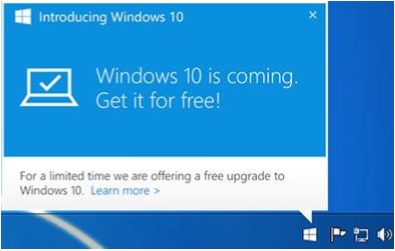
Step 2 − By clicking on the notification, it will start the download and installation process of Windows 10 in your system.
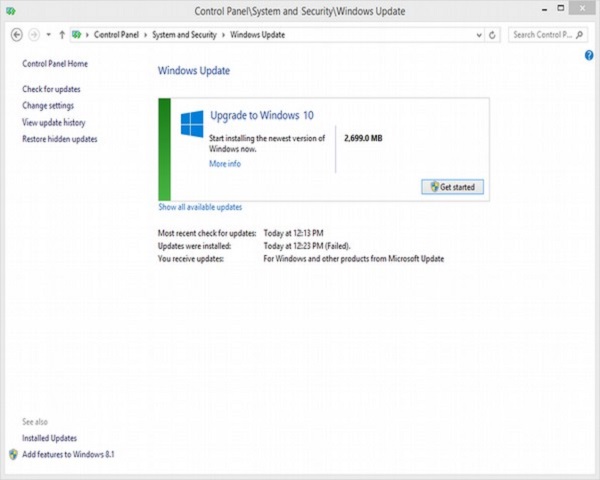
The download required for the upgrade is quite large, so make sure you have a stable Internet connection and continuous power for your computer to avoid interruptions during the process.
Step 3 − After the download is complete, it will prompt you to accept Microsofts license terms.
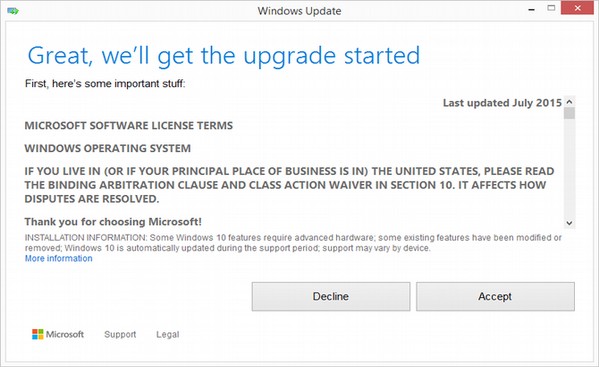
Step 4 − After agreeing to the terms, it will ask if you want to install the upgrade at that moment or schedule it for later.
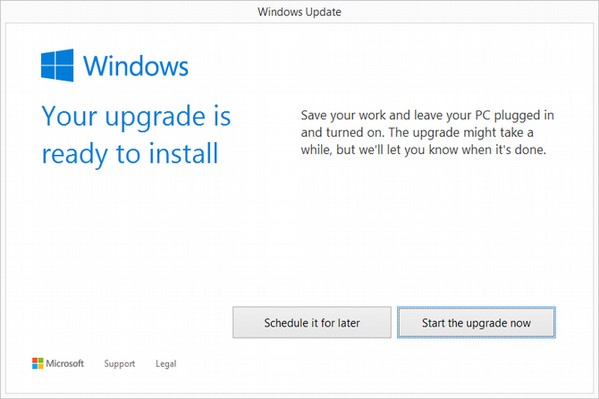
Since the upgrade process can take approximately 2 hours, it will be helpful to schedule it for a time, that will be more suitable to you.
Step 5 − Once the upgrade starts, the system will perform a series of tasks, during which you will see the following screen.
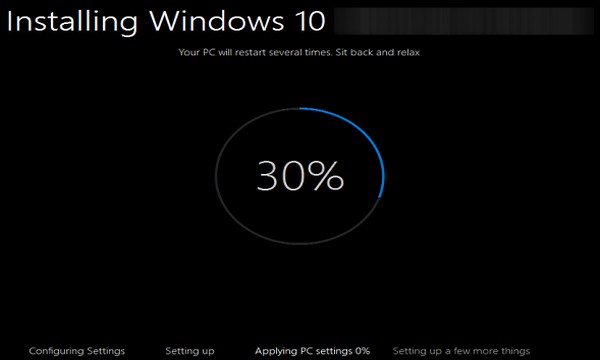
During this time, your computer will reboot a couple of times, so dont worry. The process itself will take you through the steps to complete the upgrade.
Step 6 − As the upgrade approaches its end, it will ask you to configure some basic Windows settings. You can choose to use Express settings, which will apply the most common or recommended settings, or you can choose to customize the settings as you please.
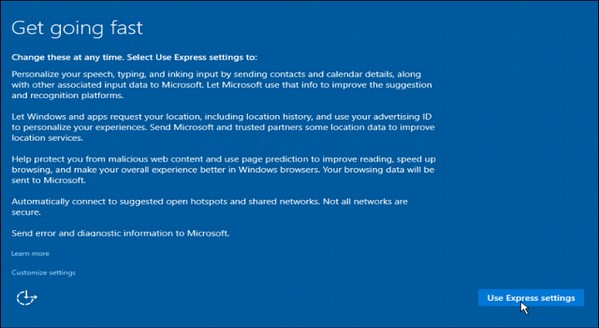
Step 7 − After the upgrade finishes, youll see the Windows welcome screen.
Clean Install
If your computer has an older operating system like Windows XP or Vista, you wont be able to upgrade for free. In these cases, youll need to buy a boxed copy of Windows 10 to have a valid license for the installation. Windows 10 will have a starting price of $119.
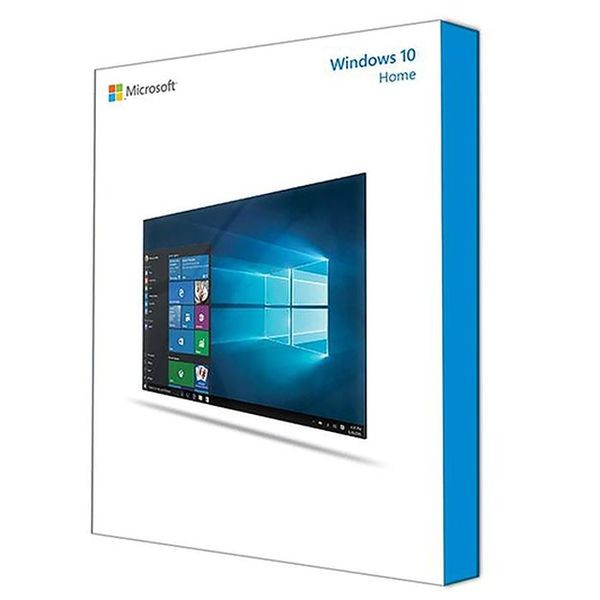
But take in consideration that old computers that have either XP or Vista installed might have obsolete hardware components and might not be suitable for Windows 10. In this case, make sure you review the system requirements listed at the beginning of this chapter to check if your computer is qualified for a Windows 10 upgrade.
If you choose this type of an installation, just insert the disc in your computer and turn it on. Most computers will ask you to press a specific key to boot from the CD/DVD, but most systems use the F12 key. After accessing the disc, you just have to follow the steps which are very similar to the ones from the upgrade.
Windows 10 - Getting Started
After you have installed or upgraded your Windows, you will get a Welcome Screen with the time and date. Just click anywhere to go to the User Accounts Screen.
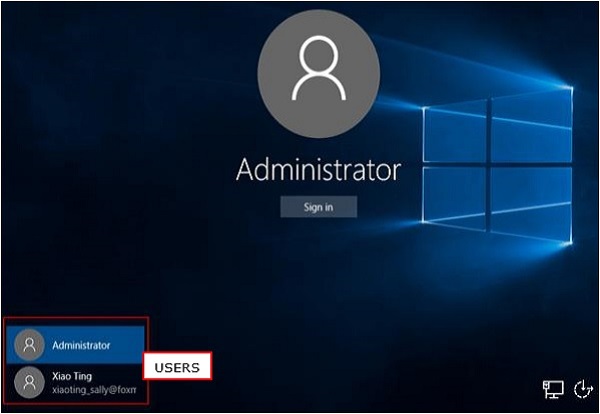
This screen lets you choose which user you want to log in to from the lower-left corner. After choosing the right user, and entering a password if necessary, you will see the Windows Desktop.
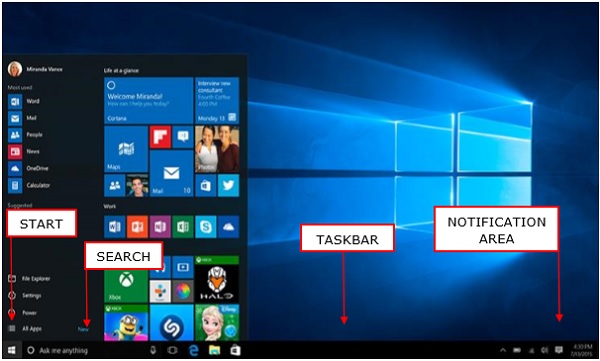
The Windows Desktop is simply your operating system main screen. Here you have access to an array of tools like the Start Menu, Taskbar, and other icons. Windows 10 also introduces a search box in the Taskbar, which facilitates browsing both your computer and the Web.
Windows 10 - GUI Basics
Once you get to the Windows Desktop screen, here are some basic features you will see.
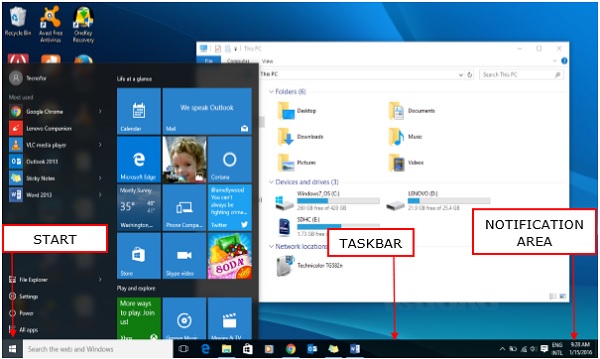
One of the most important parts of your Desktop is the Taskbar. By default, it sits at the bottom of your screen giving you access to the Start Menu, several application icons, and the Notification Area.
Windows
In Windows 10, if an application is active or opened, you will see a green line below its icon. Clicking the icon will bring the application window up.

Every open window features three buttons in the upper-right corner. These are used to minimize, maximize, or close the window −
- Minimizing means that the window will hide in the Taskbar.
- Maximizing will bring the window to a full-screen size.
Windows can be moved around or resized as you please −
To move a window, just click on its Title Bar on the upper side of the window and drag it.
To resize a window, move your mouse to any corner until you see a double-sided arrow. Then click and drag until you reach the desired size.
Icons
Most Windows versions will feature different icons on the background. An icon is simply a graphic representation of an application or a file. To open or access an icon, just double click on it.
Although the amount and type of icons will vary, depending on the computer, you can add more icons by following these steps −
Step 1 − Right-click on the Desktop Background.
Step 2 − Choose New and Shortcut.
Step 3 − Browse for the application or file you want to create a shortcut to.
Step 4 − Assign a name to the shortcut and click Finish.
Icons can also be moved around by clicking on them and dragging them to another place in the screen.
Desktop Background
Another component of your Desktop is the Background. This is simply an image that appears at the back of your screen. Most computers come with a pre-selected background, but you can change it to any image you want.
To change the background, follow these steps −
Step 1 − Right-click on the background and choose Personalize.
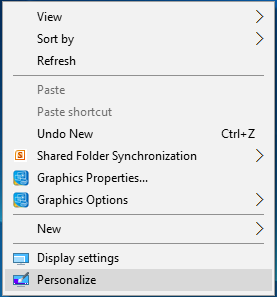
Step 2 − From the Personalization window, choose from a series of pre-selected pictures or browse for your own.
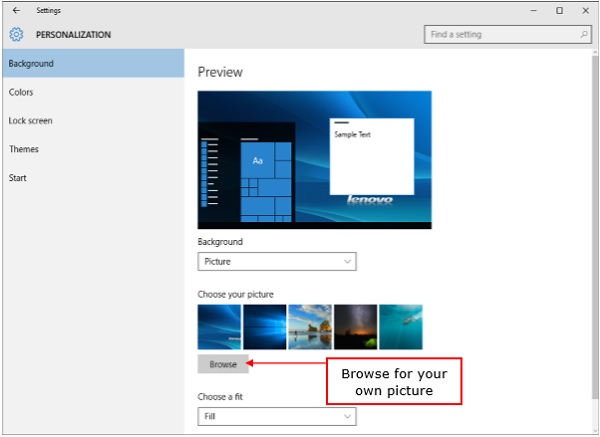
After choosing a picture, the Background will change automatically.
Windows 10 - Navigation
To navigate your Windows, you can simply type what you are looking for on the Taskbar search. It can be the name of a document or application, or just any information you are looking for.
Start Menu
If you are looking for a specific application, you can also open the Start Menu and click All Applications. This will open an alphabetical list of all the applications installed on your computer.
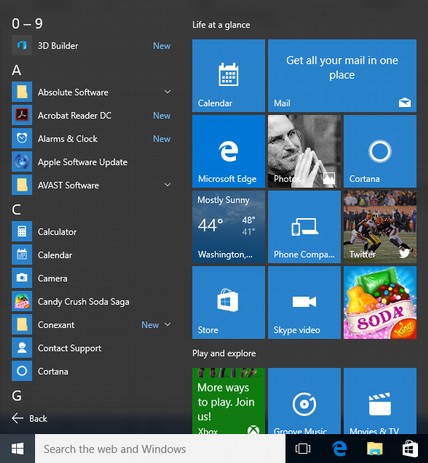
File Explorer
If you are looking for a specific document, another alternative is to use the File Explorer by clicking on the Folder icon on the Taskbar.

In the File Explorer window, you can browse all your folders and documents.
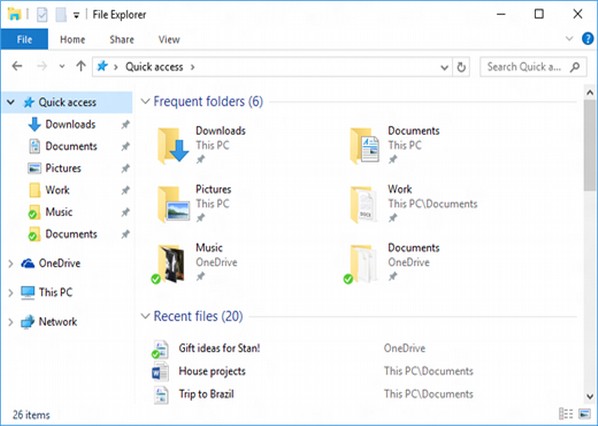
Virtual Desktops
One of the new features of Windows 10 is the addition of Virtual Desktops. This allows you to have multiple desktop screens where you can keep open windows organized.
To add a virtual desktop, follow these steps −
Step 1 − Click Task View on the Taskbar.
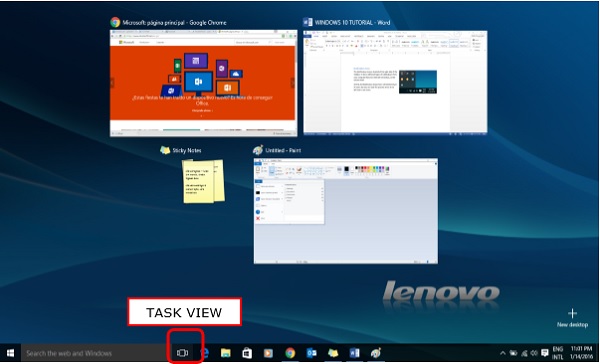
Step 2 − Click the New desktop option on the lower-right corner. You can access or delete the new Desktop by clicking Task View again.

Windows 10 - Start Menu
The Start Menu is the main point of access to your applications. There are two main ways to open it −
Step 1 − Use your mouse to click Windows icon in the lower-left corner of the taskbar.
Step 2 − Press the Windows key on your keyboard.
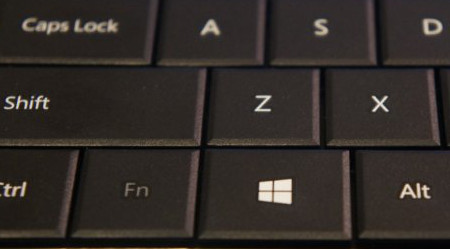
The Windows 10 Start Menu features two panes.

The left pane resembles the traditional Start Menu from Windows 7 and earlier, while the right pane features live tiles that were used in Windows 8.
Left Pane
Among the things you can do in the left pane are −
Click the username at the top of the menu to change account settings or log in with another user.
Access the applications you use more frequently.
A small arrow next to an application will open a sub-menu with a list of recent documents opened with that application.
Open the File Explorer to navigate your folders and files.
Change the settings of your computer like your Internet connection or changing your background.
See different options to shut down your computer.
See a list of all the applications installed in your computer.
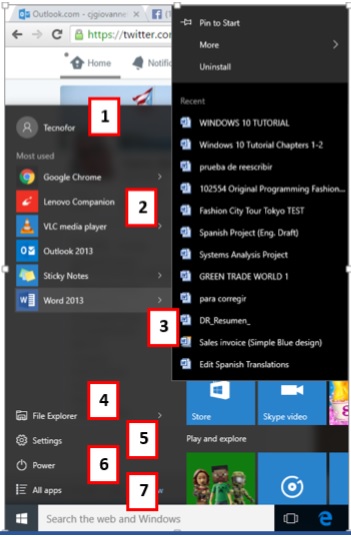
Search Box
The Search box on the Taskbar will allow you to search within your documents and files or on the Web for anything you write. The initial results will appear within the Start Menu itself.
The results will be grouped according to the closest match (or matches) labeled Best match at the top of the list.
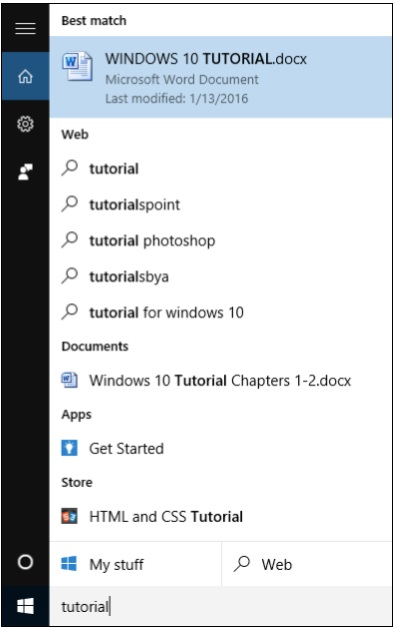
The remaining results will be grouped according to what they are or their location −
- Web results
- Documents or folders
- Apps
- System settings
The icons on the left side of the menu do the following −
 The Gear icon will allow you to configure the settings of your Search.
The Gear icon will allow you to configure the settings of your Search.
 This icon will let you send Feedback to Microsoft on what you like or dislike about Windows.
This icon will let you send Feedback to Microsoft on what you like or dislike about Windows.
 The Cortana icon will activate Windows new personal assistant.
The Cortana icon will activate Windows new personal assistant.
Clicking My stuff or Web at the bottom will expand the Start Menu and limit your results to the location you choose, as well as streamlining the search.

Right Pane
The right pane features a varied array of tiles, similar to the ones that were seen on the Start Screen of Windows 8.
These tiles can be moved and dragged to different places by holding the mouse button.
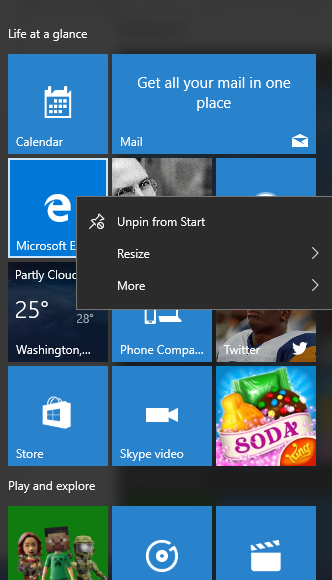
You can also configure them by right-clicking on them to see options to resize them or unpin them (remove them) from the Menu.
The whole Start Menu can also be resized by dragging the borders with the mouse to the desired size.
Windows 10 - Taskbar
The Windows 10 taskbar sits at the bottom of the screen giving the user access to the Start Menu, as well as the icons of frequently used applications. On the right-side, the Taskbar features the Notification Area which informs the user of different things like the state of the Internet connection or the charge of the laptop battery.

The icons in the middle of the Taskbar are pinned applications, which is a way to have a quick access to applications you use frequently. Pinned applications will stay in the Taskbar until you unpin them.
Pin an Application to the Taskbar
Step 1 − Search for the application you want to pin in the Start Menu.
Step 2 − Right-click on the application.
Step 3 − Select More option at the top of the menu.
Step 4 − Select the Pin to taskbar option.
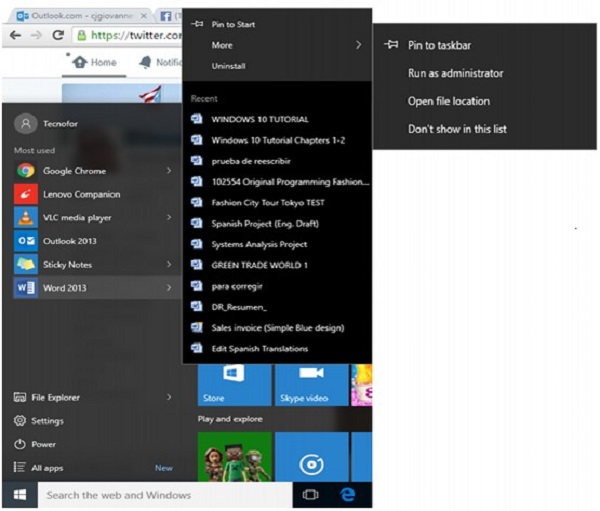
This will attach or pin the application icon to your Windows Taskbar.
Unpin an Application from the Taskbar
To unpin it, just right-click the icon in the Taskbar and select Unpin from taskbar. You can pin it back again any time you want.
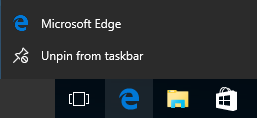
Notification Area
The Notification Area is located at the right side of the Taskbar. It shows different types of notifications from your computer like your Internet connection, or the volume level.
At first, the Notification Area shows a limited amount of icons. But you can click the upward arrow on its left-side to see other icons as well.
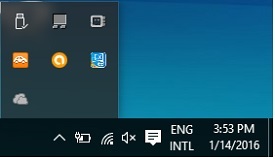
Task View
Task View allows you to quickly move within your open windows and applications. You can access it by clicking the Task View button from the Taskbar.

You can also press and hold the Windows key, and then press Tab to achieve the same result.
By pressing the Alt+Tab keyboard shortcut also serves a similar purpose.
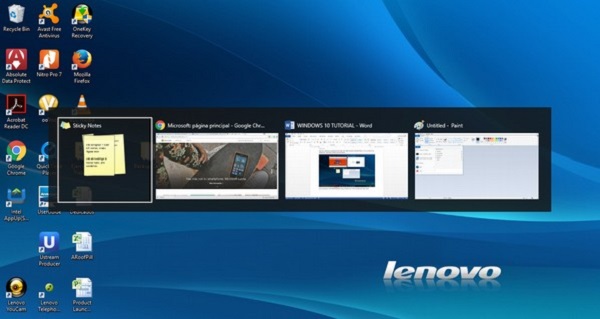
Windows 10 - Tablet Mode
The Tablet Mode is a new feature in Windows 10, which allows the user to switch the system interface, whenever a tablet is detached from a base or dock. When the Tablet Mode activates, the Start Menu goes full-screen. During Tablet Mode, many other windows like the File Explorer or the Settings window also open at full screen.
How to Activate the Tablet Mode?
Step 1 − Open the Start Menu and select Settings.
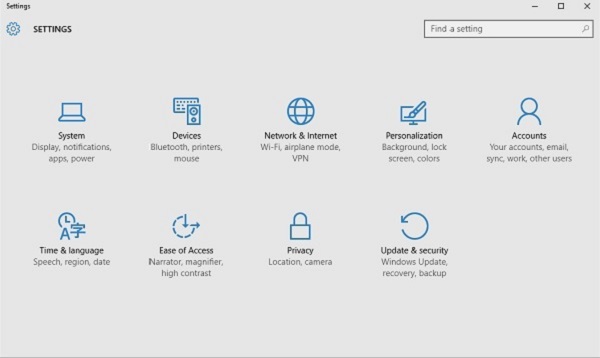
Step 2 − Select the System option.
Step 3 − Turn the Tablet Mode switch from Off to On.
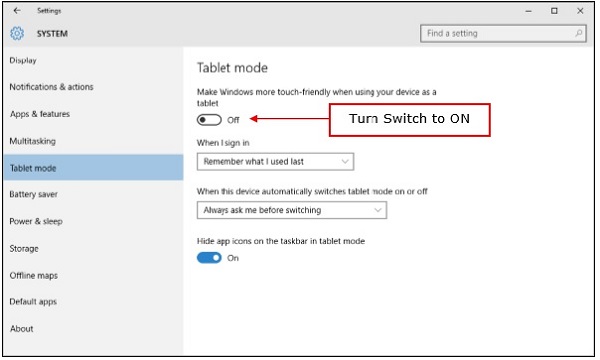
Windows 10 - File Explorer
File Explorer is the file management application used by Windows operating systems to browse folders and files. It provides a graphical interface for the user to navigate and access the files stored in the computer.

The main way to access the File Explorer is by clicking the folder icon in the Taskbar. After clicking the icon, the File Explorer window will open.
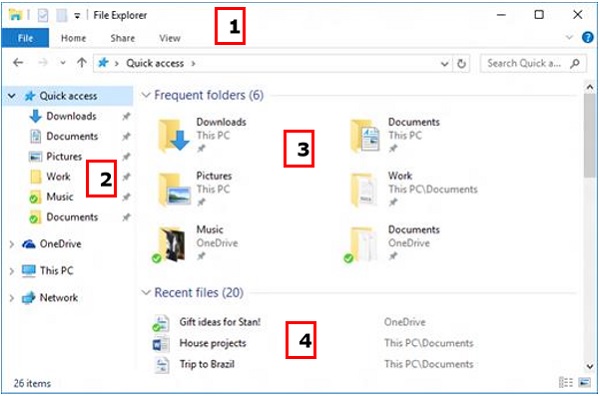
The initial File Explorer window is comprised of the following sections −
The File Explorer ribbon, which resembles the ribbon featured in Microsoft Office. The ribbon contains buttons for common tasks to perform with your files and folders.
The Navigation Pane gives you access to your libraries of documents and pictures, as well as your storage devices. It also features frequently used folders and network devices.
The Frequent folders section on the right features the folders youve worked with recently to allow for quick access to them.
The Recent files section in the lower part of the window features files and documents that youve opened recently.
The File Explorer Ribbon
In Windows 10, the File Explorer features a new ribbon toolbar, similar to the one featured in the recent versions of Microsoft Office. This ribbon contains buttons and commands for the most common tasks.

The Ribbon features four tabs, each with different commands. Among the tasks you can perform from the Home tab are −
- Copying and pasting files and folders from one place to another.
- Moving files and folders to another location.
- Copying files and folders to another location.
- Deleting a file or folder permanently or sending it to the Recycle Bin.
- Renaming a file or folder.
- Creating a new folder or other new items.
- Verifying or modifying the Properties of a document or folder.
- Opening a file or folder.
- Different options to select one or various files and folders.

The Share ribbon gives you different options to share your files and folders. For example −
- E-mailing or messaging a file.
- Compressing (Zip) a folder to take less space.
- Printing or faxing documents.
- Sharing with other users or networks.

The View ribbon allows you to change the way Windows displays your files and folders. Some of the changes you can make here are −
- Adding additional panes to show a preview or details of your files.
- Changing the layout of the files and folders from icons to list, and others.
- Sorting and arranging the contents of your folder.
- Hiding selected folders or files.
The File tab opens a menu with different options like −
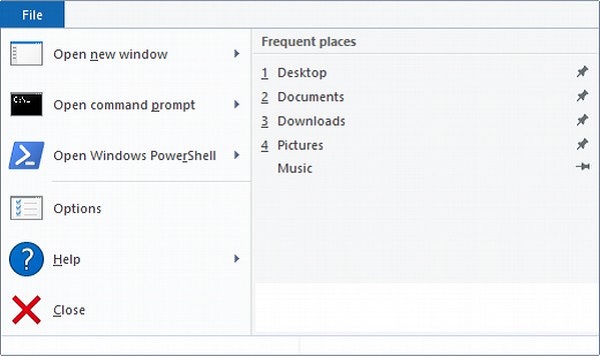
- Opening an additional File Explorer window.
- Opening command windows for advanced users.
- Changing or configuring options about how File Explorer behaves.
Windows 10 - Cortana
Cortana is Microsofts intelligent personal assistant. It is included in Windows 10, as well as with other Microsoft systems and devices like Windows Phones and Xbox, among others.
Cortana will help you find things in your computer, set appointments, answer questions, and many other things.
To use Cortana simply type a question in the search box in the Taskbar, or click the microphone icon and talk to Cortana.
The icons on the left-side are for −
- Home
- Notebook
- Reminders
- Feedback
Home is the initial Cortana window where you can type or ask questions.
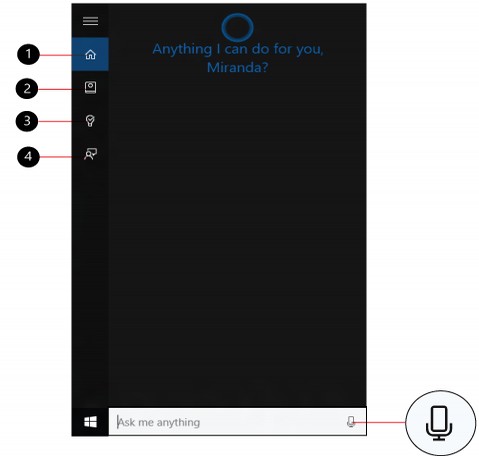
Activating Cortana
If Cortana isnt active, you can turn it on by typing Cortana in the Taskbar search to access the Cortana settings, or just clicking the Gear icon on the left-side of the menu.
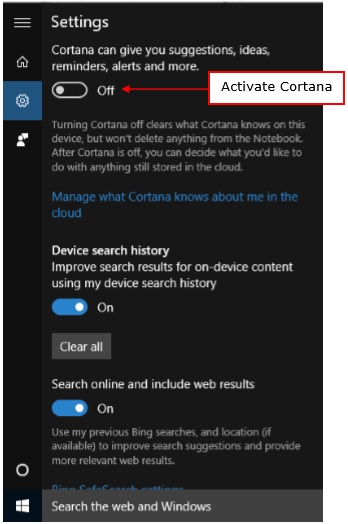
After activating Cortana, it will start gathering information about you to personalize the experience.
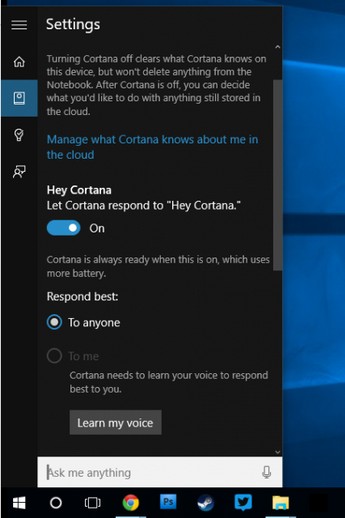
You can also customize how Cortana responds to you.
Personalizing Cortana
To further customize Cortana and personalize your interactions with it, you can also access the Cortana Notebook.
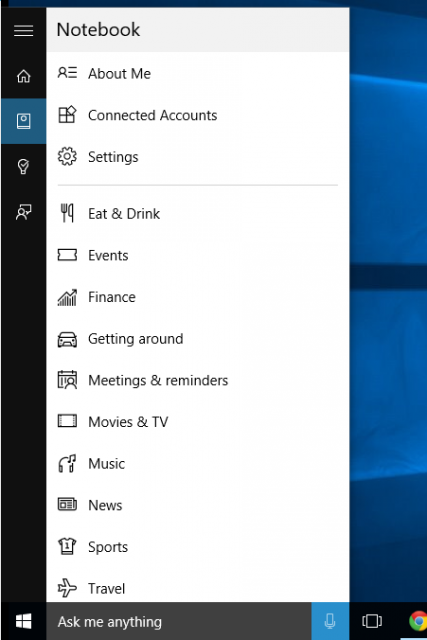
This notebook stores what Cortana knows about you.
You can also add reminders by either typing them or talking to Cortana.
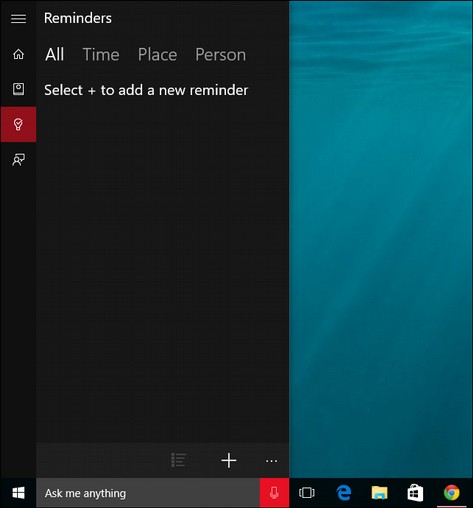
Windows 10 - Notifications
Windows 10 features a new way to present notifications. You can see them in the Notification Area in the lower-right corner of your screen.
 Clicking the Notification icon will bring up a sidebar called the ACTION CENTER.
Clicking the Notification icon will bring up a sidebar called the ACTION CENTER.
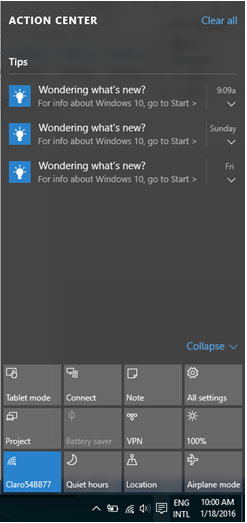
The upper part of the sidebar features Tips and App notifications, while the lower part of the sidebar presents a series of Quick Action buttons.
Customizing Notifications
You can customize what notifications Windows 10 presents you in the sidebar by following these steps −
Step 1 − Go to the SETTINGS window and choose System.
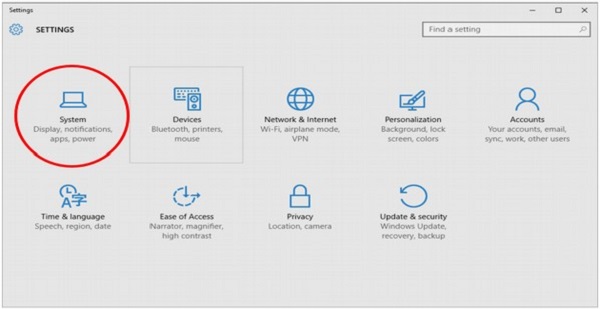
Step 2 − In the SYSTEM window, select Notifications & actions. The screen will then show you different settings where you can customize what notifications Windows 10 will show.
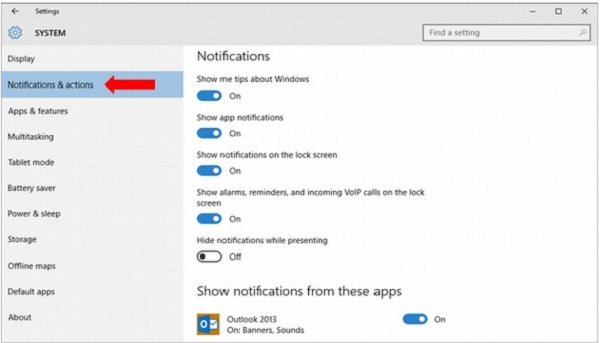
Windows 10 - Quick Actions
Quick Actions are a set of tiles that give you access to frequently used settings and tasks (like Wi-Fi connection, or screen brightness).
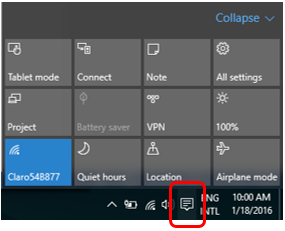
Most of the actions can be configured simply by clicking or tapping on the tile. Additional settings and options can be accessed if you right-click the tile.
![]() Selecting the All settings tile will take you directly to the SETTINGS window.
Selecting the All settings tile will take you directly to the SETTINGS window.
Customizing Quick Actions
With these Notifications, you can customize the Quick Actions tiles by going to the SETTINGS window.

After opening Settings, you can choose SYSTEM and then select Notifications & actions.
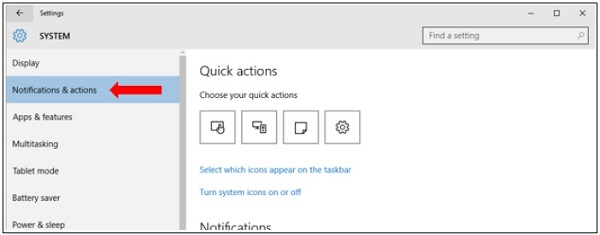
Windows 10 - Cloud
Windows 10 allows you to sign in using an Outlook account. By doing this, Windows synchronizes your documents, contacts, and other things to the cloud. To sign in with Outlook, follow these steps −
Step 1 − Go to SETTINGS and choose Accounts.
Step 2 − In the ACCOUNTS window, choose Sign in with a Microsoft account instead.
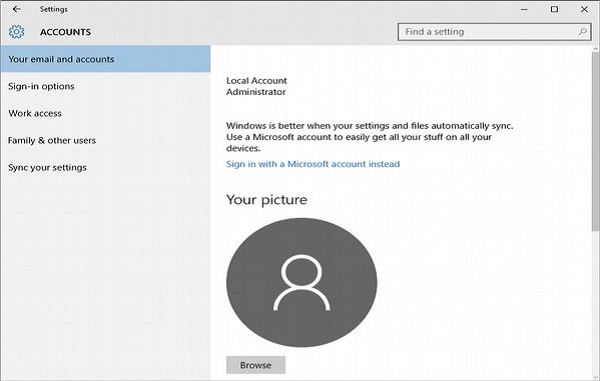
Step 3 − After that, Windows will ask for your username and password. If you dont have a Microsoft or Outlook account, it will also provide a link to create one. Using a Microsoft account will allow you to sync your documents and personal files to any compatible device, where you use that account.

Using OneDrive
By signing in with a Microsoft or Outlook account, you have access to OneDrive from your Windows 10. OneDrive is a free storage space in the Cloud given to every user of a Microsoft account.

To access your OneDrive from Windows, simply click on the File Explorer icon in the Taskbar.
When the File Explorer window opens, you will see the link to OneDrive on the left side of the screen.
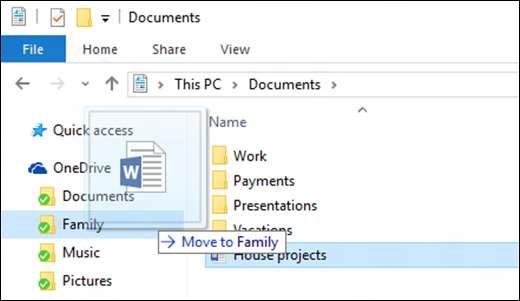
You can move documents from your local folders into OneDrive by dragging them with your mouse or your finger.
OneDrive uses different icons to show you the status of your files and folders −
 A green checkmark means that the document or folder is in sync with the online version.
A green checkmark means that the document or folder is in sync with the online version.
 A blue double-arrow means that the document or folder is currently syncing.
A blue double-arrow means that the document or folder is currently syncing.
 A red X means that there was some issue or problem syncing the document or folder.
A red X means that there was some issue or problem syncing the document or folder.
Windows 10 - Universal Apps
With Windows 10, Microsoft has launched an initiative for applications to be universal across their different platforms. This means that an application designed for your computer can also work in a Windows Phone, an Xbox, or any other Windows-compatible devices.

To achieve this, Windows developed the Universal Windows Platform (UWP) and improved the Windows Store to serve as the unified storefront for all Windows apps. To access the Windows Store, users can click the icon on the Taskbar. This will open the Windows Store allowing the user to browse for any app he wants.
Windows also allows cross-buys, which means that buying the license for an application on one device, also applies to any other compatible device the user has.
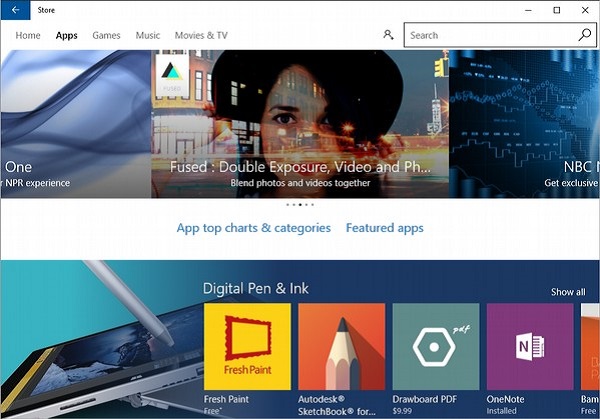
Windows 10 - Multiple Desktops
One of the innovative features of Windows 10 operating system is the addition of Virtual Desktops. This allows you to have multiple desktop screens, where you can keep open windows organized.
To add a virtual desktop, follow these steps −
Step 1 − Click Task View icon on the Taskbar.

Step 2 − Click New Desktop option on the lower-right corner. You can access or delete the new Desktop by clicking Task View icon again.

Windows 10 - Users Management
Like most Windows versions since XP, Windows 10 allows you to log in to different user accounts when using your computer. Like we discussed earlier, you can choose which account you want to log in to after turning on the computer.

But you can also configure or manage your user account after youre logged in. To do this, follow these steps −
Step 1 − Open the Start Menu.
Step 2 − Click on Settings.
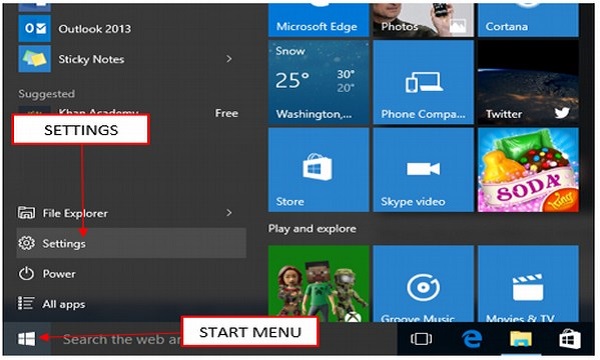
Step 3 − From the SETTINGS window, choose Accounts option.
Step 4 − In the ACCOUNTS window, choose the account setting you want to configure.
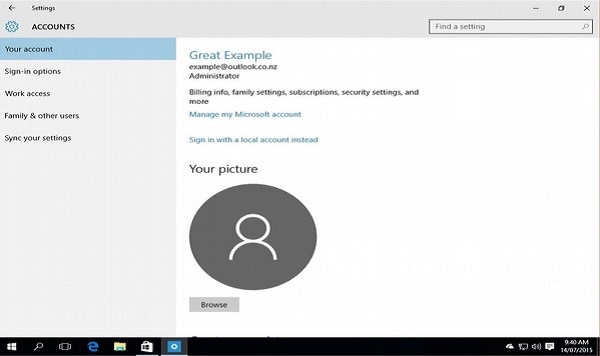
If you want to change your sign-in options, like your password, select Sign-in options.
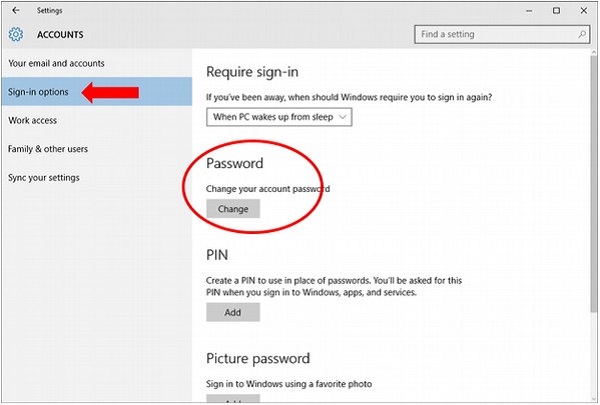
Under Sign-in options, Windows 10 lets you change your password. It also lets you choose when the computer will ask you to sign in.
Windows 10 - Security
Windows 10 features a series of tools to help you protect your computer from threats like viruses and other malware. The three main security tools are −
- User Account Control
- Windows Defender
- Windows Firewall
User Account Control
The Windows User Account Control is a tool that warns you when someone or something attempts to change your computer system settings. When this happens, the screen will alert you until an Administrator can confirm the change. This helps protect your computer against accidental changes or malicious software altering your settings.
Initially, this User Account Control is set at a moderate to high level, which means it will notify you only when an application tries to make changes to your computer. However, you can change this setting to your desired level by following these steps −
Step 1 − Open the Control Panel by searching for it in the Search bar.

Step 2 − After the Control Panel is open, choose User Accounts.
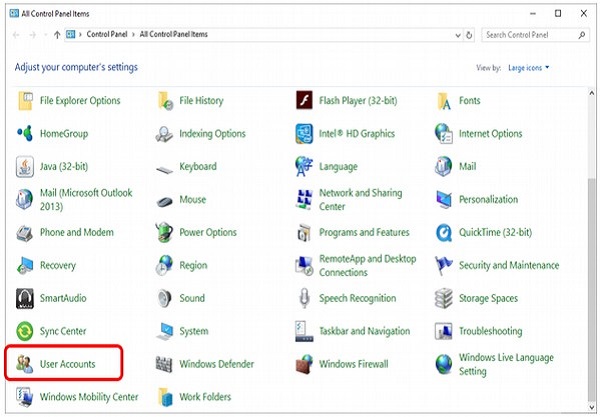
After choosing User Accounts, click on Change User Account Control settings.
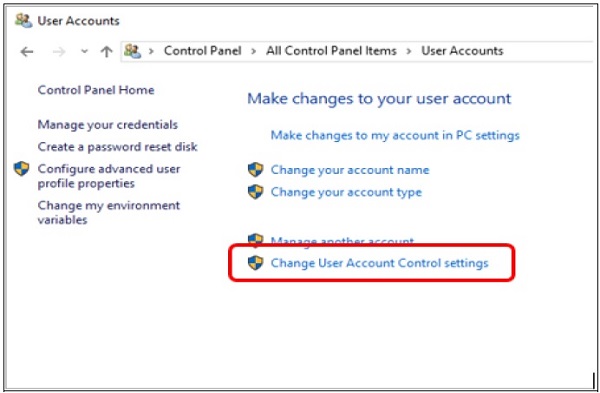
In the User Account Control Settings, you can move the slider to the desired position. Windows 10 will give you a summary of how your system will behave under that level.
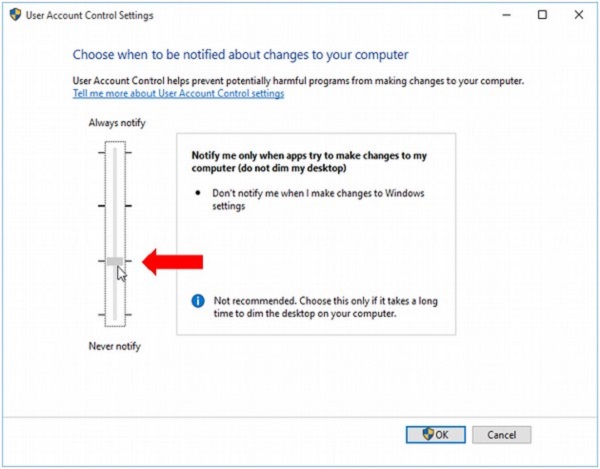
Windows Defender
Windows Defender is an antivirus and malware protection included in your operating system. It allows you to scan your computer for malicious software, while also checking each file or program you open.
To configure Windows Defender, follow these steps −
Step 1 − Go to SETTINGS and select Update & security.
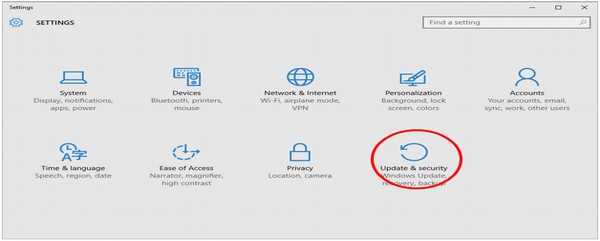
Step 2 − In the UPDATE & SECURITY window, select Windows Defender.
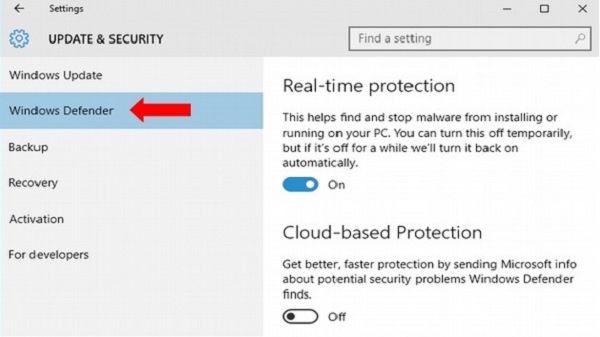
Here you can customize settings like turning off real-time protection or activating cloudbased protection, which allows Defender to send Microsoft information about security threats it finds.
Windows Firewall
Windows Firewall prevents unauthorized access from outside to get into your computer. By default, it is turned on to protect your computer and your network.
If you want to customize your Firewall, follow these steps −
Step 1 − Open the Control Panel by searching for it in the Search bar.

Step 2 − When the Control Panel is open, choose Windows Firewall.
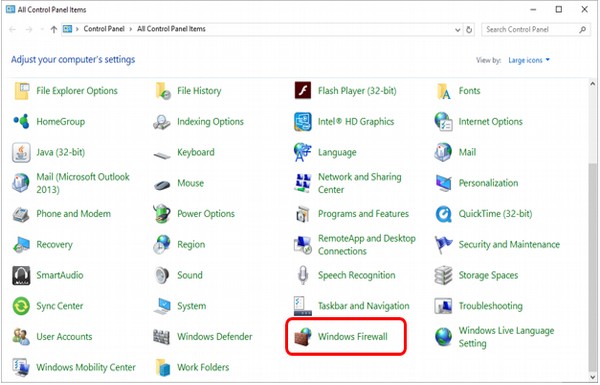
Step 3 − In the Windows Firewall window, you can customize the settings of it by turning it on or off or choosing when to protect your computer.
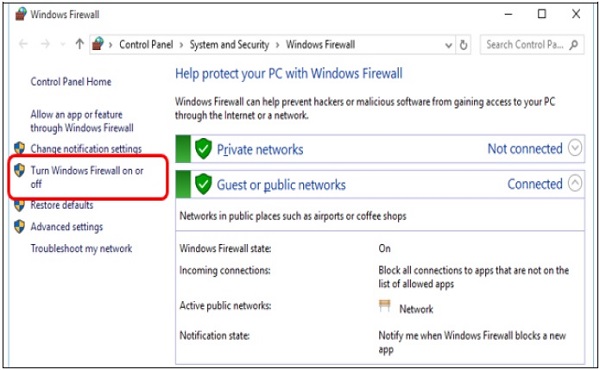
Windows 10 - Parental Control
Windows 10 allows you to set up a childs account for your children. This account will allow you to establish restrictions on how the account is used and monitor what your child does.
To create a childs account, follow these steps −
Step 1 − Go to SETTINGS and choose Accounts.
Step 2 − In ACCOUNTS, select the Family & other users option.
Step 3 − Click the Add a family member button.
Step 4 − Choose what family member you want to add (child or adult)
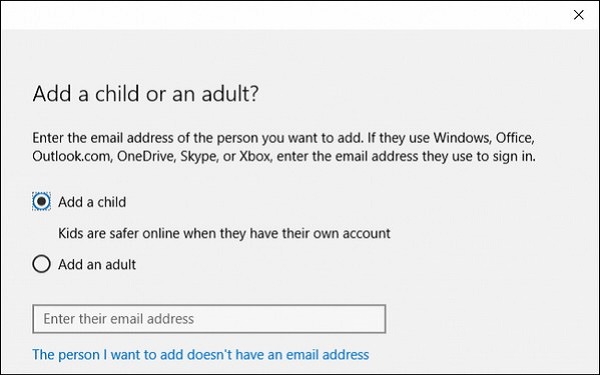
Step 5 − You will then be prompted to create an account for your child. If they dont have an e-mail account, you can create an Outlook account for them.
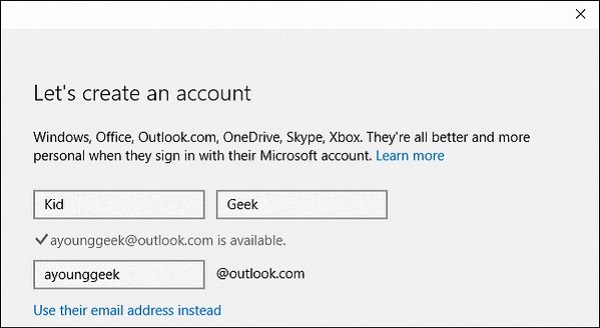
Step 6 − Provide a phone number for account security. This will be used in case the account is hacked or inaccessible.
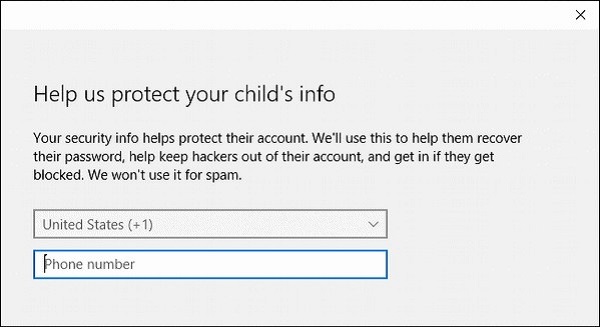
Step 7 − Choose from some notification and experience options, for example, if you want to receive promotional offers from Microsoft.
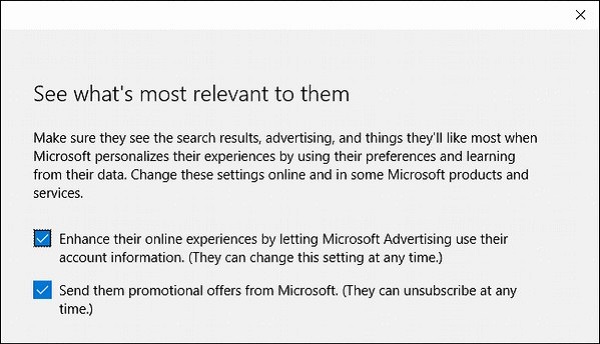
After creation, your child can log in to his own Windows 10 account.
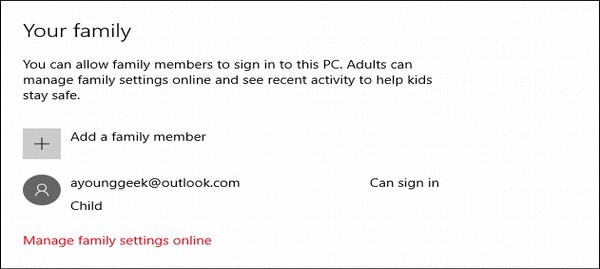
In addition, you can choose to monitor what your child does in his account by turning on reports on his activity −

You can also choose to block inappropriate websites to limit your childs browsing only to allowed websites.
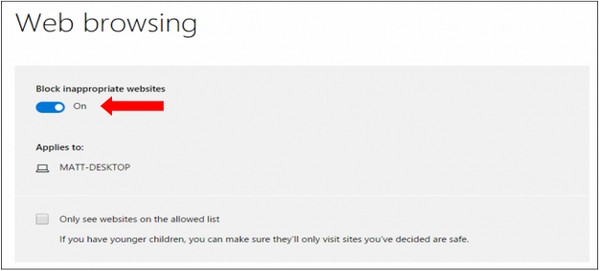
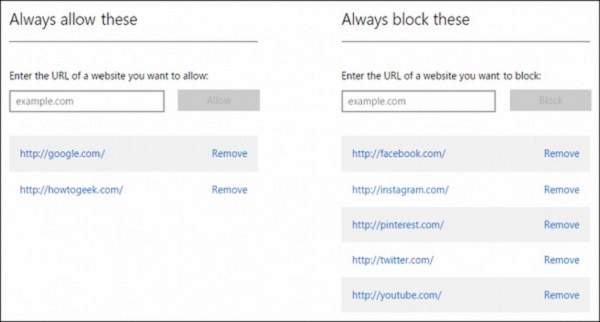
Finally, you can also establish when your child is allowed to log in by establishing a schedule −
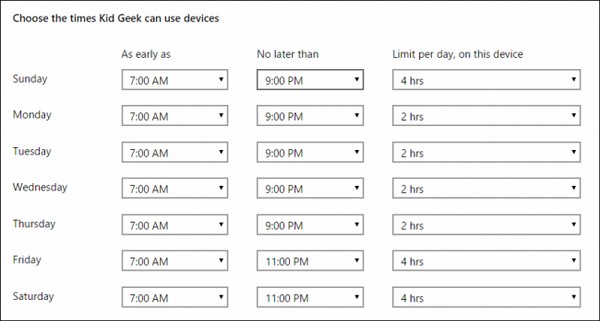
Windows 10 - Applications
Windows 10 lets you access your applications in several ways. The easiest way is to search for the name of application using the Search box in Taskbar.
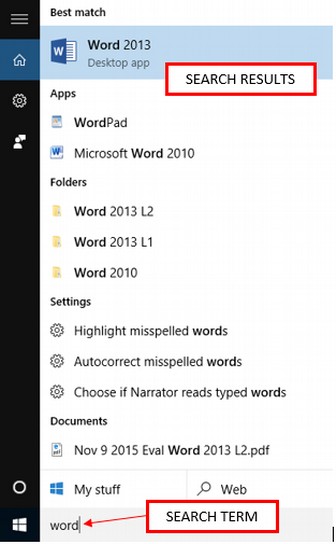
Another basic option is to open the Start Menu and click on All Apps.
After selecting All Apps, Windows 10 will present an alphabetical list of all the applications installed in your computer.
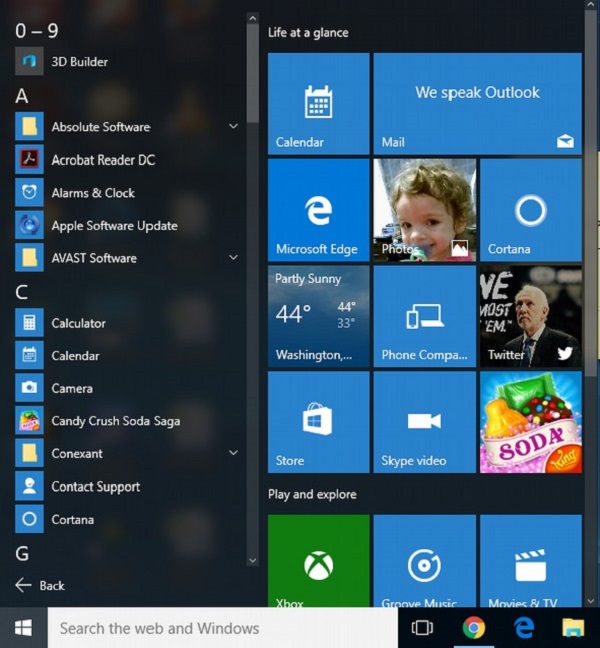
Windows 10 - Web Browsing
Windows 10 includes the first version of Microsofts new browser − Edge. By default, Edge can be accessed by clicking on the icon placed on the taskbar.
When Edge opens, it presents a window similar to most browsers.
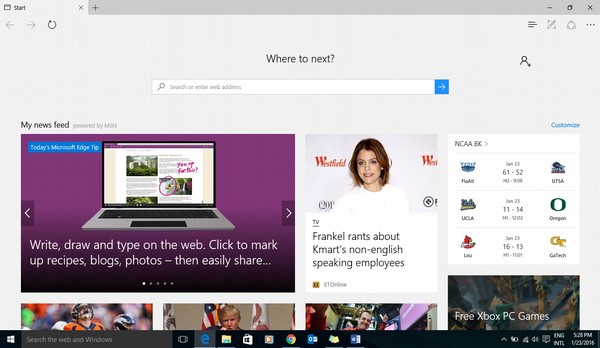
The toolbar, however, is more simplified than the Internet Explorer.

It features the following buttons −
Back − Takes you to the previous web page.
Forward − Takes you to the next web page.
Refresh − Reloads the web page.
New tab − Add another tab to see a different web page.
Hub (Favorites and History) − See lists of favorite web pages and history of visited web pages.
Web Notes − Make Web Notes on the web page.
Share − Share the web page via e-mail or other methods.
More options − See more options to configure the browser.
Adding a Web Page to your Favorites
Like most browsers, Edge allows you to store pages that you visit frequently as Favorites. To do this, follow these steps −
Step 1 − Go to the page you want to add as a Favorite.
Step 2 − Click on the Star button on the right-side of the browser.
You can then access your list of Favorite websites by clicking the Hub button on your browser.
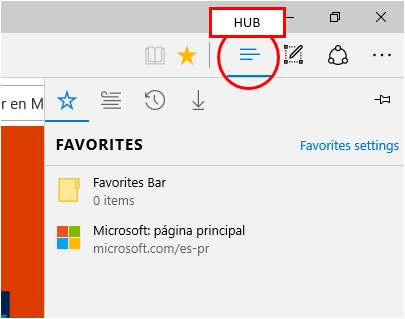
Reviewing Browsing History
The same Hub button can also present you a list or History of web pages youve visited.
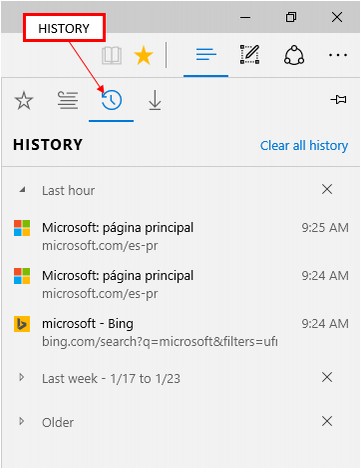
If you wish, you can clear the history by clicking on the Clear all history option in the menu.
Windows 10 - Networking
Like previous Windows version, Windows 10 will let you know the status of your network connection in the Notification Area.
If the connection is wireless, you will see this icon.
If the connection is wired, you will see this icon.
Wired Connection (Ethernet)
If your network connection is through cable, you can access its settings by going to the SETTINGS window, and selecting Network & Internet.
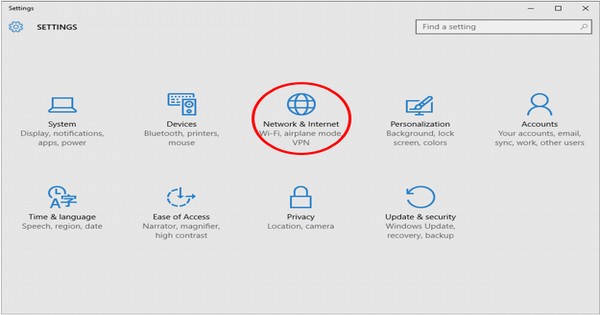
In the NETWORK & INTERNET window, click on Ethernet to see the settings of your connection.

Wireless Connection (Wi-Fi)
If your connection is wireless, clicking on the wireless icon will show you details of your connection as well as other wireless networks available.
Clicking on Network settings will take you to the Network & Internet window, which presents more specific details about your connection, and options to configure it.
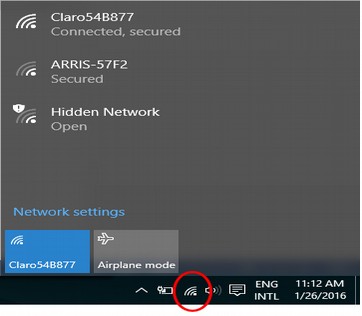
In the NETWORK & INTERNET window, you can turn your Wireless Network Connection on or off
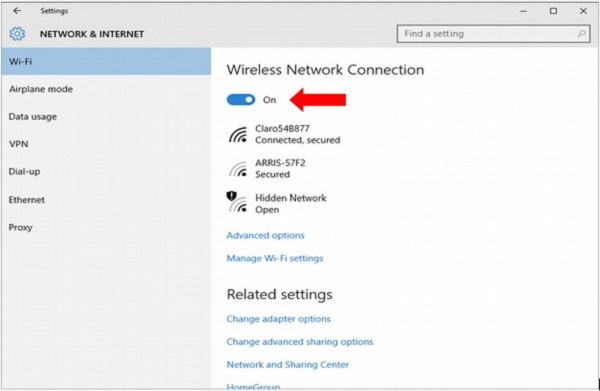
Windows 10 - Virtualization
One of the features that Windows 10 has included is the capacity of creating virtual machines. A virtual machine is the software emulation of a computer system. They are created within a real or physical computer, allowing you to create multiple separate computers that can run different operating systems and programs. These virtual machines are handled using a special software called a Hypervisor. In this case, Microsofts own Hyper-V.
Due to the advanced nature of virtualization, not all computers can run virtual machines. In the past, this feature was reserved for servers. But with operating systems like Windows 10, users can create their own virtual machines too.
Pre-requisites in Windows 10
The basic pre-requisites for creating and running virtual machines in Windows 10 are the following −
A 64-bit edition of Windows 10 Pro or Windows Enterprise. Hyper-V isnt available for Windows 10 Home edition.
Your computer processor needs to support virtualization, or more specifically SLAT (Secondary Level Address Translation).
Virtualization has to be enabled in your computers BIOS. This is a small program that handles the boot-up of your computer making sure everything is in the right place.
What Windows version do you have?
To find out what specific Windows version you have, follow these steps −
Step 1 − Open the Control Panel by searching for it in the Search bar.

Step 2 − After the Control Panel is open, choose System.
Step 3 − In the System window you can see what specific Windows version and what type of processor (CPU) your computer has.
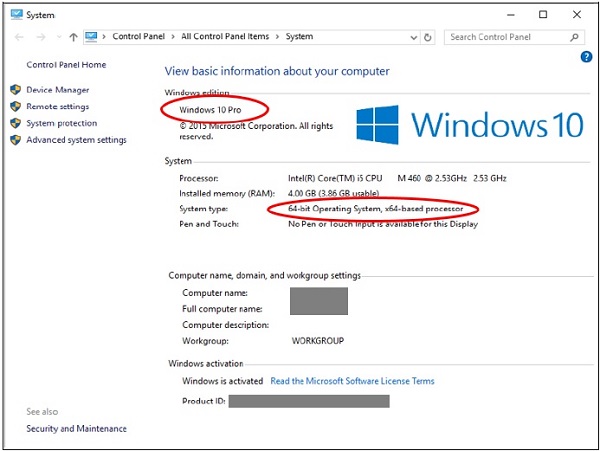
Enabling Virtualization in the BIOS
The BIOS is a small program that runs whenever you turn on your computer. Its basic function is to help the computer boot up by making sure everything is working properly. However, it also controls some advanced features within your computer, some of which have to be enabled in order to work. One example is Virtualization.
To enable virtualization, follow these steps −
Step 1 − Restart your computer and enter the BIOS setup. This is done by pressing a key just as the computer is turned on. The key you have to press varies from one system to another, but it usually is F2, F10, or Delete. Most systems tell you which key to press to enter the setup, or you can consult your computer manual.
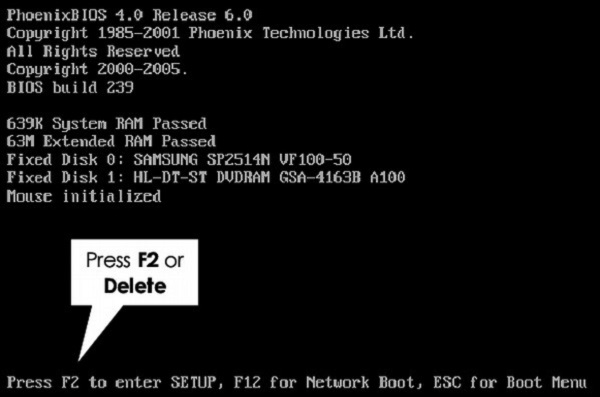
Step 2 − After entering the BIOS setup, you must enable all virtualization settings. The BIOS also varies greatly from system to system, depending on the brand.
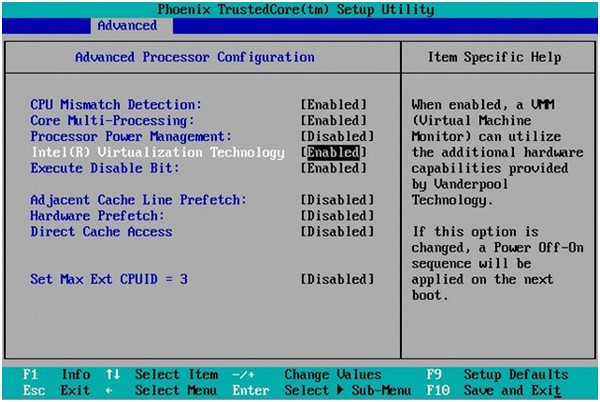
Step 3 − After enabling all necessary settings, save and exit the BIOS setup. This is usually done by pressing F10. After this, the computer will restart.
Setting Up Hyper-V
To create and manage virtual machines, you need to set up Microsoft Hyper-V. To do this, follow these steps −
Step 1 − Open the Control Panel by searching for it in the Search bar.

Step 2 − After the Control Panel is open, choose Programs and Features.
Step 3 − In the Programs and Features window, click Turn Windows features on or off.
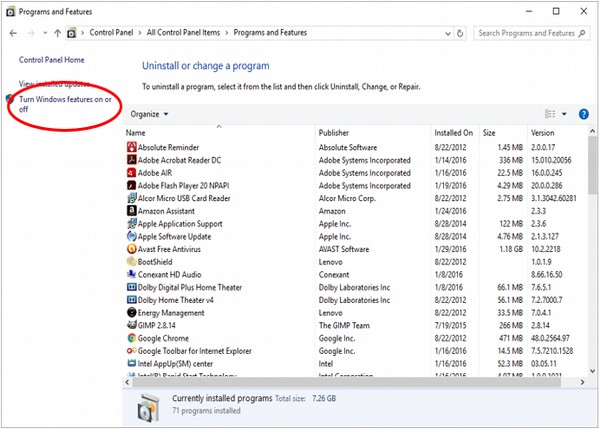
Step 4 − In the Windows Features window, look for the Hyper-V feature and check all the boxes.
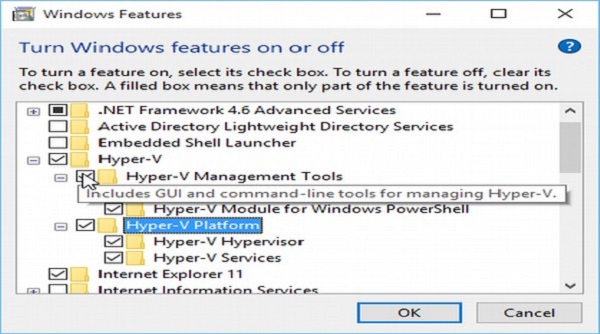
Windows will then install and configure Hyper-V, after which it will ask you to restart and confirm the changes. It will then go through a series of restarts to finish configuring your system.
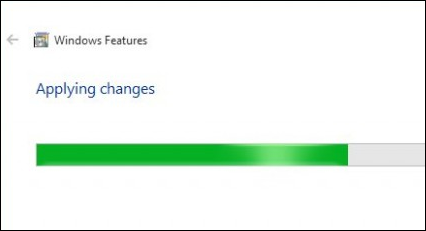
Using Hyper-V to Create a Virtual Machine
After Hyper-V finishes installing, you can open it and use it to create virtual machines in your Windows 10 computer. To start Hyper-V and create a virtual machine, follow these steps −
Step 1 − Enter Control Panel and select Administrative Tools.
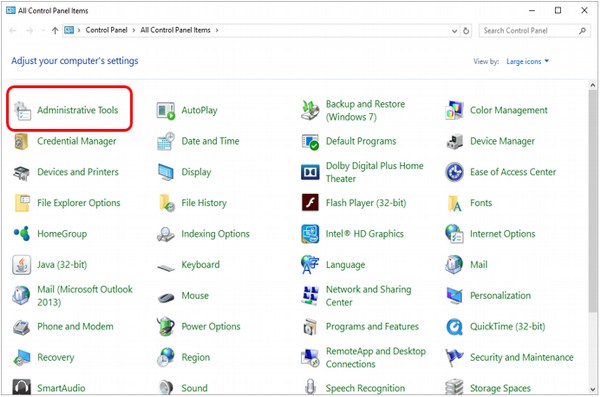
Step 2 − In the Administrative Tools window, click on Hyper-V Manager.
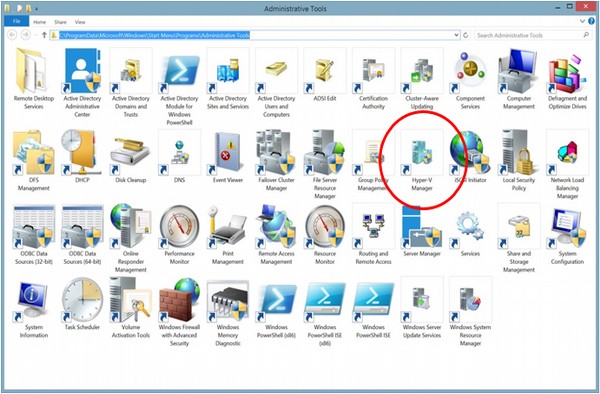
Step 3 − When Hyper-V starts, you will see the name of your computer on the left-side of the application. Select the computer to work on it.
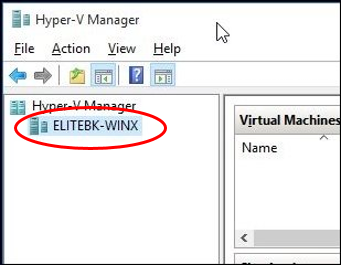
Step 4 − On the Action menu, select New and Virtual Machine.
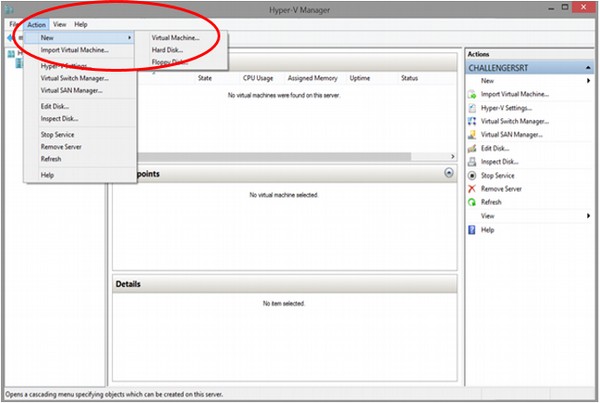
You can also do this from the sidebar on the right-side of the application, under Actions.
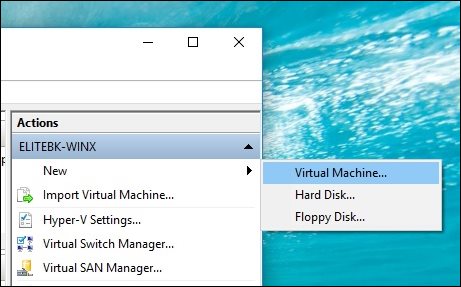
Step 5 − Hyper-V will open the New Virtual Machine Wizard to help you in the process of creating a virtual machine. Here you can click the Finish button to create a virtual machine with some basic configurations. Advanced users can click Next to go through the steps of creating a customized virtual machine.
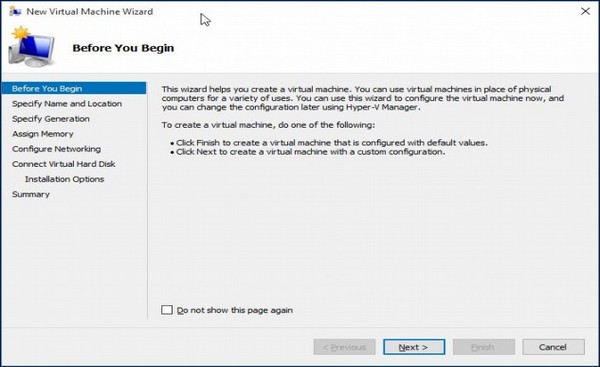
Step 6 − After the virtual machine is created, you will see it inside the Hyper-V window.
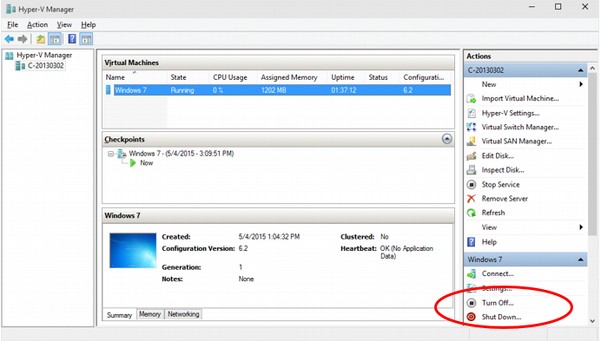
Like real, physical computers, virtual machines need to have an operating system installed in order to work. Hyper-V allows you to turn them on or shut them down using the buttons on the right side.
Windows 10 - Remote Access
Remote Desktop is a feature that allows you to access another computer on a remote location from your computer.
Allowing Remote Access to your Computer
To use Remote Access, the remote computer must be configured first to accept remote connections. This setting is turned off by default to avoid unwanted connections, but to turn it on, follow these steps −
Step 1 − Open the Control Panel by searching for it in the Search bar.

Step 2 − After the Control Panel is open, choose System.
Step 3 − In the System window, note the Computer Name; youll need it later.
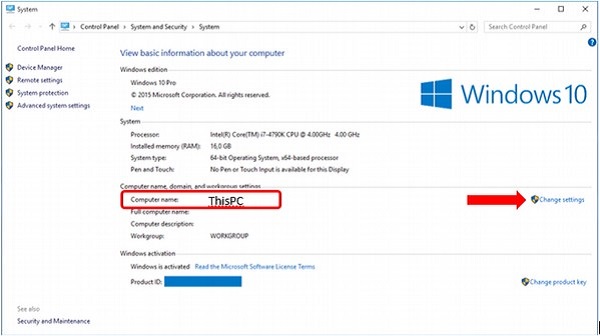
Step 4 − After that, click the Change settings link to open the System Properties window.
Step 5 − In the System Properties window, you can review the Computer Name again, and then click on the Remote tab.
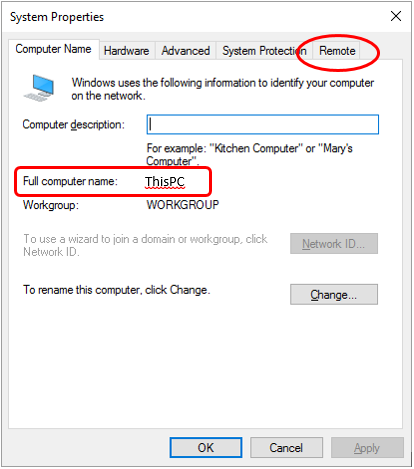
Step 6 − In the Remote tab, select the option that reads Allow Remote connection to this computer.
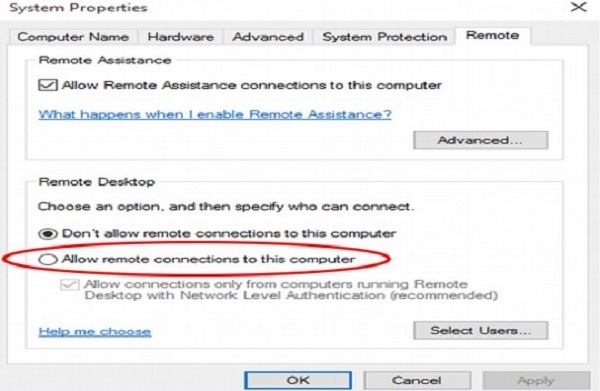
Step 7 − After selecting the appropriate option, make sure you click Apply or OK to save your changes. This will allow other users to access your computer remotely.
Use Remote Desktop to access another Computer
Now that youve ensured that the remote computer will allow your connection, follow these steps to access it remotely.
Step 1 − Open the Remote Desktop Connection window by searching for it in the Taskbar.
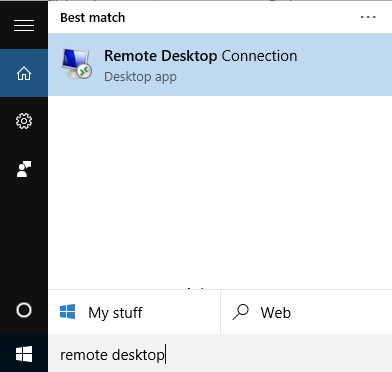
Step 2 − On the Remote Desktop Connection window, type the name of the computer you want to access and click Connect.
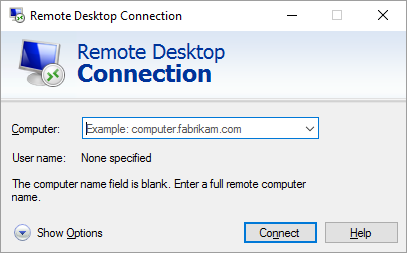
Step 3 − After this, you will see the Desktop of the remote computer appear, allowing you to work in it.
Windows 10 - Backup & Recovery
Windows 10 features several tools to help you perform backups of your documents. Here are some of these tools.
File History
File History will perform a back-up of the files located in your libraries (Documents, Pictures, Music, etc.) It allows you to choose a drive, where you can back-up your files and then asks you when to do it.
To configure the File History backup, follow these steps −
Step 1 − Go to SETTINGS and select Update & security.

Step 2 − In the UPDATE & SECURITY window, select Backup.
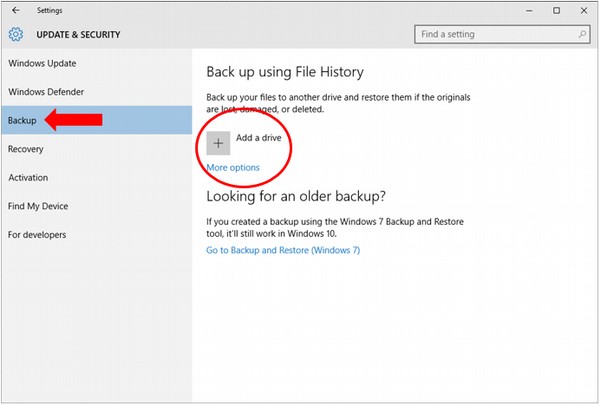
Step 3 − Click Add a drive to choose where to store your backup.
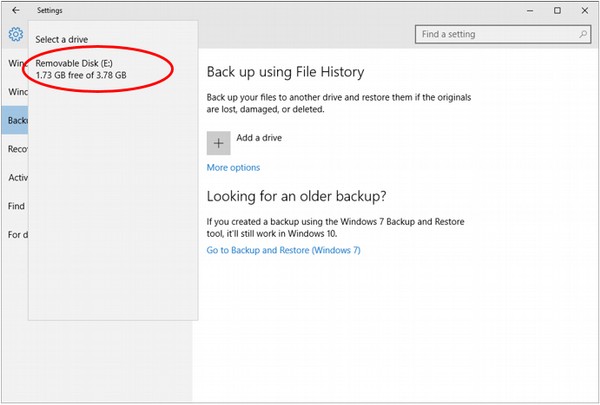
Backup & Restore (Windows 7)
This tool, which was removed in Windows 8 and 8.1, was brought back allowing you to perform back-ups and restore data from old Windows 7 backups. However, it also lets to back-up your regular documents on Windows 10.
To open the Back-up & Restore, follow these steps −
Step 1 − Open the Control Panel by searching for it in the Search bar.

Step 2 − After the Control Panel is open, choose Backup and Restore (Windows 7).
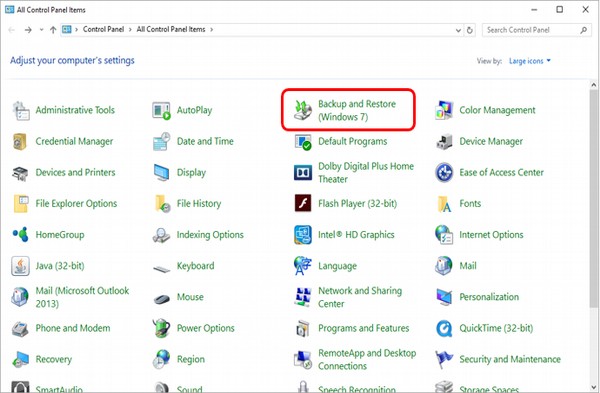
Step 3 − In the Backup and Restore window, you can choose to Set up backup.
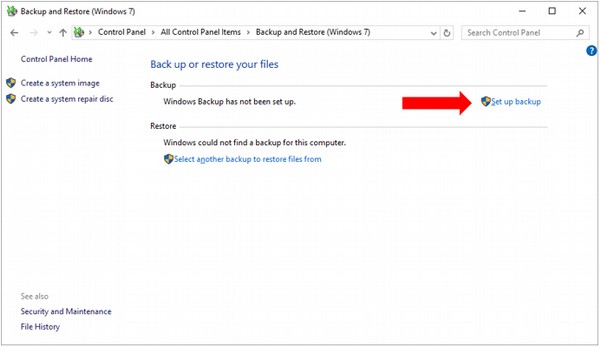
Step 4 − In the Set up backup window, choose where you want to store your backup.
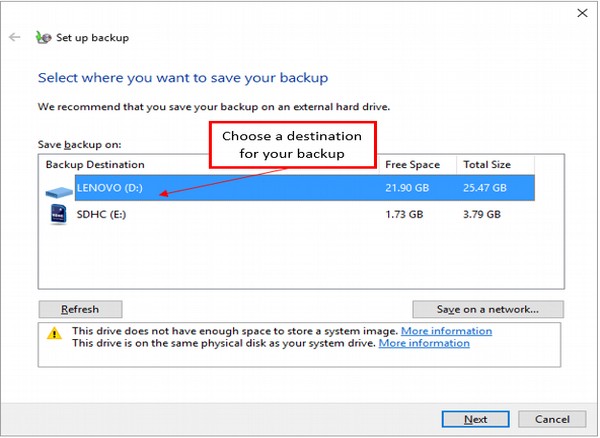
When choosing any of the listed storage devices, Windows 10 will give you information about that specific device. After choosing the desired destination, click Next.
Step 5 − In the next window, you can choose what files you want to backup.
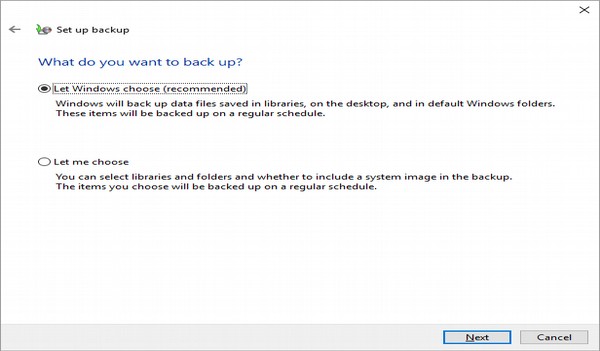
Windows default is to store everything in your libraries (Documents, Pictures, etc.) and in your Desktop, but you can also choose specific files and folders to backup. After making your selection, click Next.
Step 6 − In the last window, you can review the settings of your backup and establish the schedule in which you want to perform it.
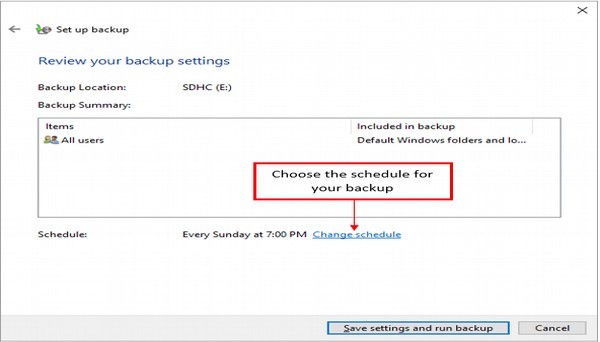
Step 7 − In the end, click Save settings and run backup. The backup will perform at the scheduled time.
Creating a System Image
In case your computer failing, Windows 10 offers you some alternatives to restore it to a specific state. One of these alternatives is creating what is called a system image. A system image is a copy of all your system and program files needed for your computer to run properly.
You can use this option to store an image of your computer at a specific moment, and use it to restore your computer to that state later. The option to create a system image is in the same Backup and Restore window we discussed before.
Step 1 − Open the Backup and Restore window from the Control Panel.

Step 2 − On the Backup and Restore window, choose the Create a system image option on the left.
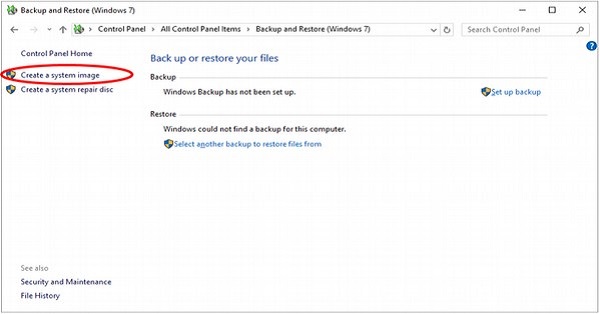
Step 3 − On the Create a system image window, you can choose where to store the backup from among three places: your hard disk, on DVDs, or in the network.
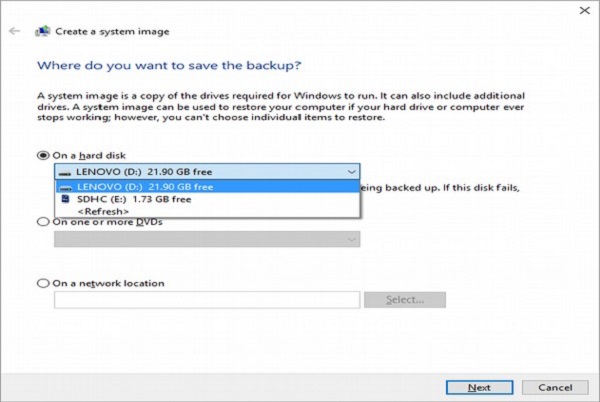
After choosing where to store the backup, click Next.
Step 4 − In the next window, just confirm your image settings and click Start backup.
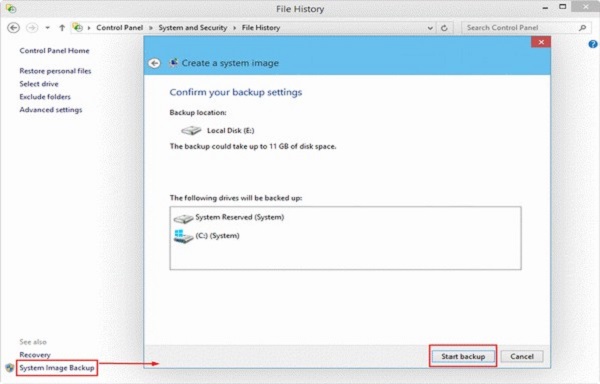
Resetting the PC
Another alternative Windows 10 offers you for system recovery is simply called Reset this PC. This option will allow you to return your computer to its default factory settings. It will also give you the option of keeping your files or removing everything. To reset your PC, follow these steps −
Step 1 − Go to SETTINGS and select Update & security.

Step 2 − On the UPDATE & SECURITY window, select Recovery.

Step 3 − On the Recovery window, you can click the Get started button under Reset this PC.
Step 4 − The next window, will ask you whether you want to reset your settings and applications, but still keep your personal files, or just remove everything and return your computer to its default state.
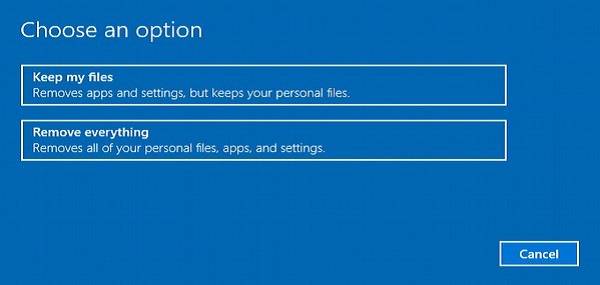
Advanced Options
Windows 10 features several advanced options to restore your PC. Although these are meant for advanced users, you can access them from the same Update & Security window that we have discussed before.
Step 1 − Open the Settings window and select UPDATE & SECURITY.
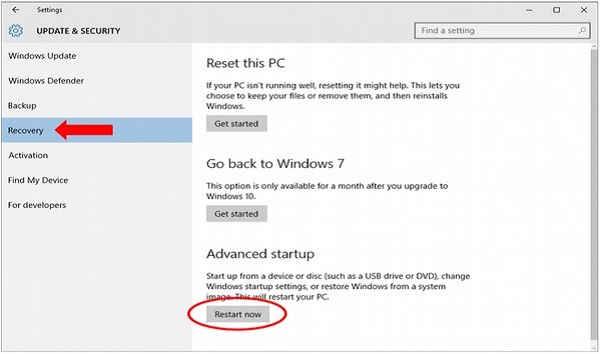
Step 2 − On the UPDATE & SECURITY window, select Recovery. Under Advanced startup, click the Restart now button.
Step 3 − When Windows 10 restarts, it will present you a menu of options to select from.
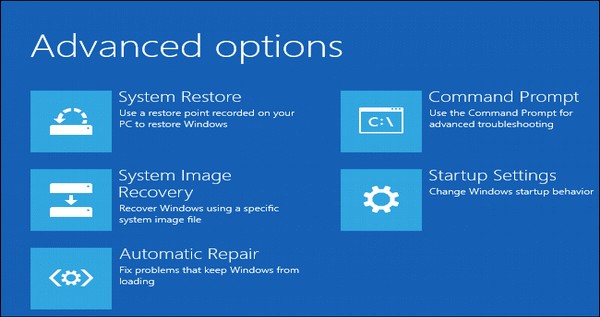
The same menu will appear whenever Windows tries to boot unsuccessfully.
Windows 10 - Project Spartan
Project Spartan was the codename assigned to Microsofts upcoming new browser. The codename was revealed in year 2014, when Microsoft informed they were working on a new browser separate from Internet Explorer.
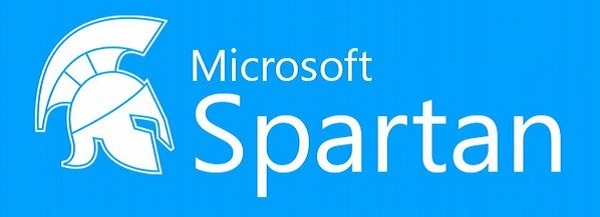
The Spartan browser was included in the first technical builds of Windows 10 released in early 2015. However, on April 2015 Microsoft announced that Spartan would be renamed as Edge.
Windows 10 - Apps Management
Windows 10 offers you multiple ways to access your applications. Like discussed earlier, one of the most basic ways is to open the Search menu and click All Apps.
This will present an alphabetical list of all the applications installed in your computer. If there is an application that was recently installed, it will be labeled as New in the menu.
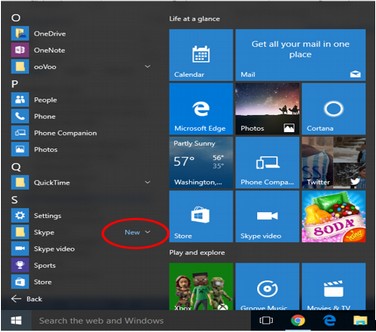
Uninstalling Applications
There are three ways in which you can remove an unwanted application −
- From the Start Menu
- From the Settings window
- From the Control Panel
Here are the steps for each way.
Uninstalling an Application from the Start Menu
Perhaps the easiest way to uninstall an application is from the Start Menu. To do this, follow these steps −
Step 1 − Open the Start Menu and click on All Apps.
Step 2 − Find the application you want to uninstall on the list, and right-click on it.

Step 3 − On the menu, choose Uninstall. After this, follow the steps needed to complete the process. These steps will vary for each application.
Uninstalling an Application from the Settings window
A new and different way to uninstall an application is from the new Settings window. To do this, follow these steps −
Step 1 − Open the Start Menu and click Settings.
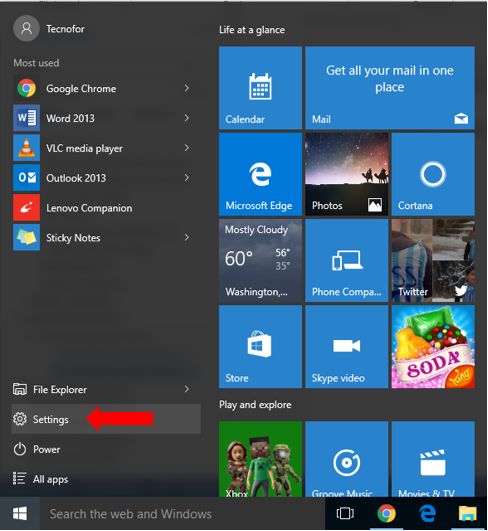
Step 2 − On the SETTINGS window, choose System.

Step 3 − On the SYSTEM window, choose Apps & features.
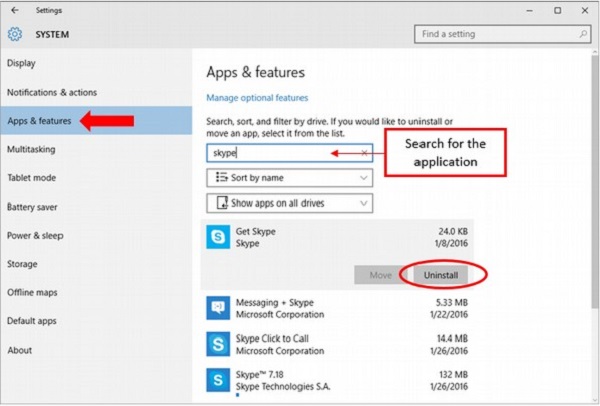
Step 4 − On the Apps & features window, search for the application you want to uninstall in the search box.
Step 5 − From the results, click on the application and choose Uninstall.
Uninstalling Applications from the Control Panel
The third way to uninstall an application is more traditional, because it uses the popular Control Panel window. To use this method, follow these steps −
Step 1 − Open the Control Panel by searching for it in the Search bar.

Step 2 − After the Control Panel is open, choose Programs and Features.
Step 3 − The Programs and Features window will present a list of all the applications installed in your computer. To uninstall an application, just click on it and use the Uninstall button.
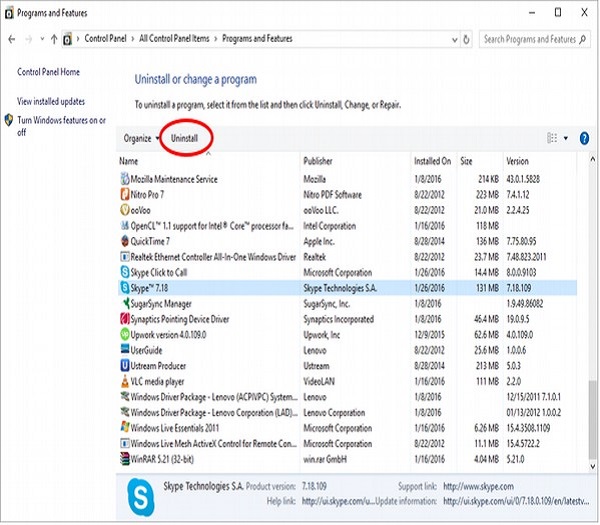
An alternate way is to right-click the application on the list.
This window also gives you other details about the applications you have installed like −
- The date it was installed.
- The size it occupies on the hard disk.
- The specific version of this application.
Windows 10 - Email Management
Windows 10 features the new Mail app to help you handle your e-mails. You can access the Mail app directly from the Start Menu.
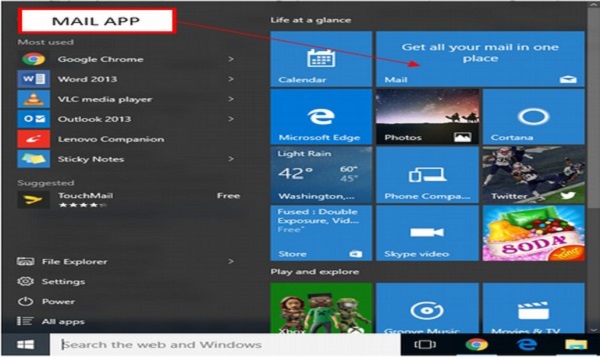
If you are connected to Windows with a mail account, the Mail app will automatically configure itself to present you your e-mails. But, if you are using a local account, the Mail app will ask you to configure it.
Configuring the Mail App
The first time you access the Mail account, you will see this window.
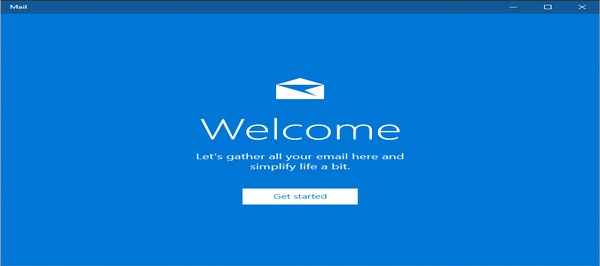
To configure it, follow these steps −
Step 1 − Click on the Get started button.
Step 2 − On the next window, add the account you want to use with Mail.
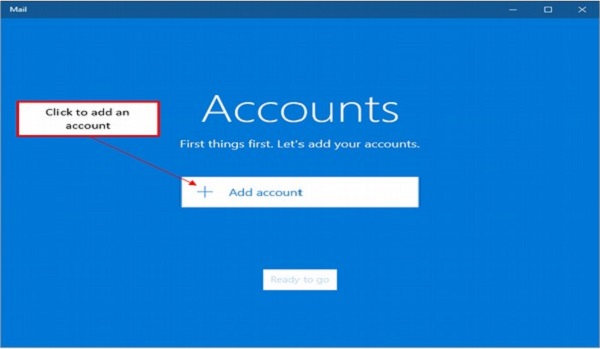
Step 3 − On the Choose an account window, select what type of account you want to configure. Mail is compatible with most of the current mail providers.
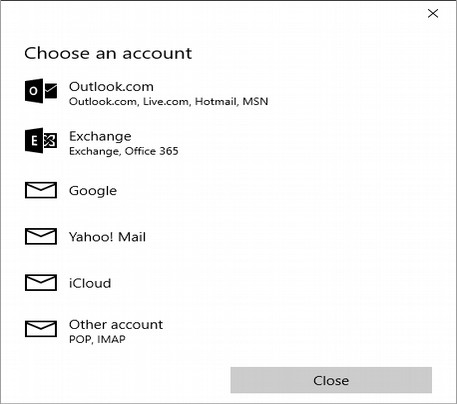
Step 4 − If youre using a Microsoft account, enter your username and password.
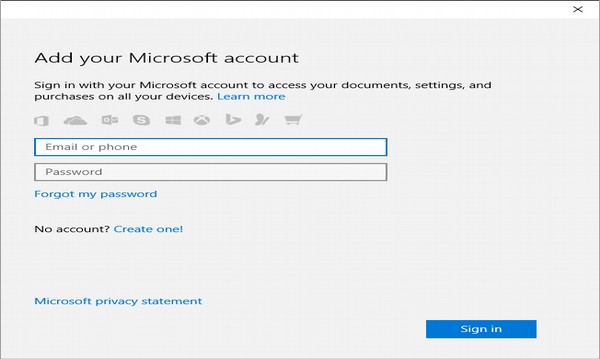
Step 5 − After a while, the Mail app will start loading your emails.
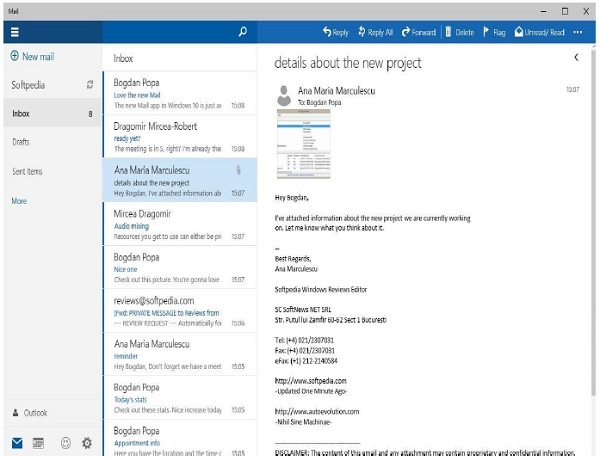
Windows 10 - Keyboard Shortcuts
Like most Windows applications, there are several keyboard shortcuts you can use to make it easier or faster for some to perform certain tasks.
Most of the new Windows shortcuts use the Windows key (  ) combined with other keys to perform several actions. The following are some of the most common or useful shortcuts used in Windows 10.
) combined with other keys to perform several actions. The following are some of the most common or useful shortcuts used in Windows 10.
| SHORTCUT | ACTION |
|---|---|
Windows key 
|
Open the Start menu |
Windows key  + S + S |
Open the Windows Search |
Windows key  + C + C |
Open Cortana |
Windows key  + Tab + Tab |
Open Task View |
Windows key  + D + D |
Show or Hide the Desktop |
Windows key  + L + L |
Lock your account |
Windows key  + A + A |
Open the Action Center sidebar |
Windows key  + I + I |
Open the Settings window |
Windows key  + E + E |
Open the File Explorer window |
Windows key  + PrintScreen + PrintScreen |
Takes a screenshot of your whole display and stores it in Pictures > Screenshots |
Window Snapping
Other useful shortcuts introduced in Windows 10 are the ones used for Windows snapping. Snapping windows was introduced in Windows 7 and allows you to automatically arrange your windows making it easier to work with multiple applications at the same time.
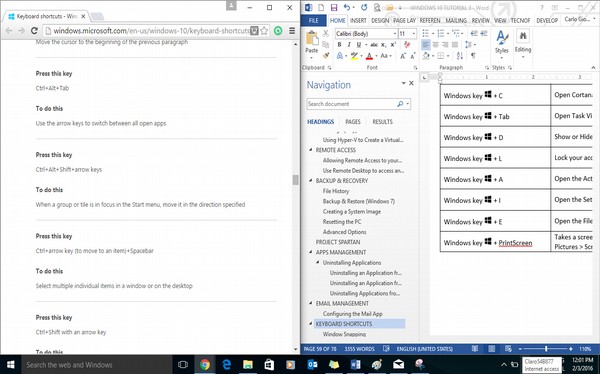
Although you can do this with your mouse by dragging the windows to each side of the screen, Windows 10 introduced shortcuts to perform this task.
| SHORTCUT | ACTION |
|---|---|
Windows key  + Left arrow + Left arrow |
Snap the active window on the left side of the screen |
Windows key  + Right arrow + Right arrow |
Snap the active window on the right side of the screen |
Windows key  + Up arrow + Up arrow |
Snap the active window on the top of the screen |
Windows key  + Down arrow + Down arrow |
Snap the active window on the bottom of the screen |
Windows 10 - System Tray
The System Tray is another name given to the Notification Area, which we can find in the right-side of the Windows Taskbar. The System Tray features different types of notifications and alerts from your computer like your Internet connection, or the volume level.

However, you can choose what icons and notifications appear here. To further customize the System Tray follow these steps −
Step 1 − Go to the SETTINGS window and choose System.

Step 2 − In the SYSTEM window, select Notifications & actions. Here you can select the option that reads Select which icons appear on the taskbar.

Step 3 − In the SELECT WHICH ICONS APPEAR ON THE TASKBAR window, you can turn on or off the icons in whichever way you prefer.
Windows 10 - Media Management
Windows 10 offers multiple ways to work with your media files (music and videos). Some of the features needed to handle these files have been integrated into Windows to facilitate the way you access them. For example, if you select a music file, you will see the following ribbon on the top of your folder window.
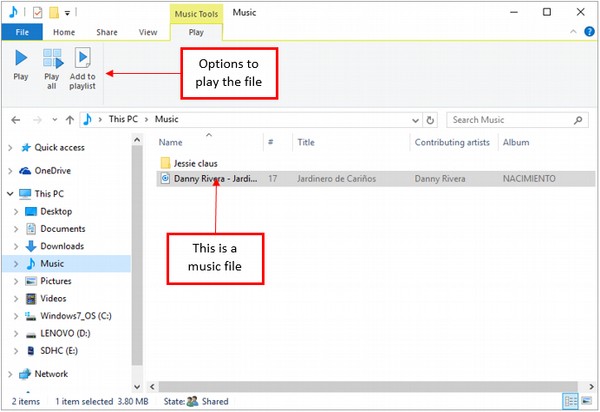
You will see similar options when you select a video file.
Media Applications
Although you can have multiple media programs in your computer, Windows 10 includes several options for you to use.
For music files, Windows includes the traditional Windows Media Player. However, new Windows versions also include the Groove Music app (previously known as Xbox Music).
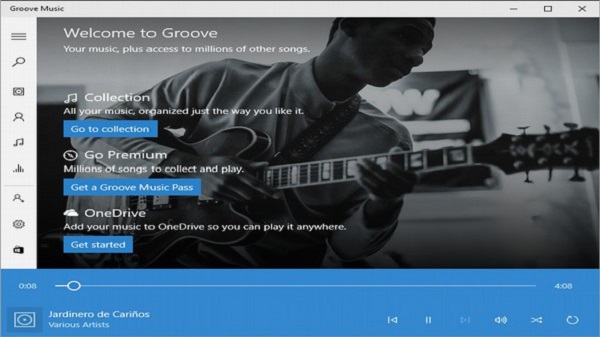
For video files, Windows also uses Windows Media Player, but now also includes the Movies & TV app.
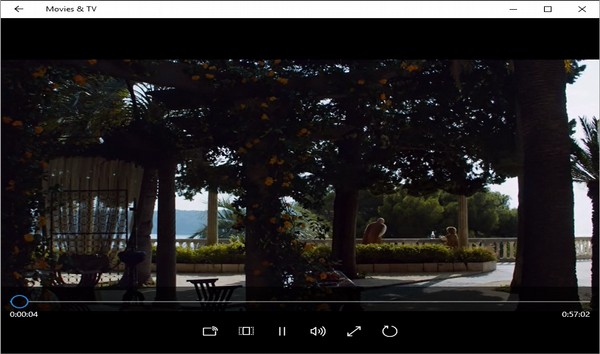
Windows 10 also includes the Windows DVD Player app for playing DVDs in your computer.
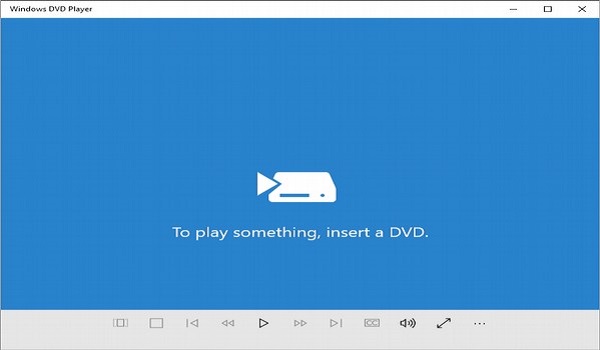
You can also choose which application you want to use to open your media file by following these steps −
Step 1 − Right-click any media file (music or video).
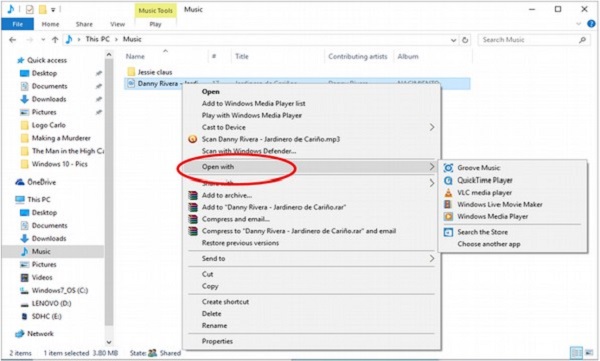
Step 2 − Select the Open with option.
Step 3 − Choose what application you want to use to open the media file.
Windows 10 - Favorite Settings
As weve seen already, Windows 10 uses the new Settings app for most of its configuration. And although the Settings app can be easily accessed through the Start menu, Windows 10 also allows you to pin your favorite setting apps to the Start menu for even easier access. A pinned setting app will appear directly in the tiles of your Start Menu.
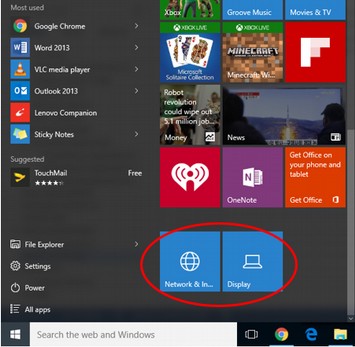
Pin your Favorite Settings
To pin your favorite settings to the Start Menu, follow these steps −
Step 1 − Open the Settings window from the Start Menu.
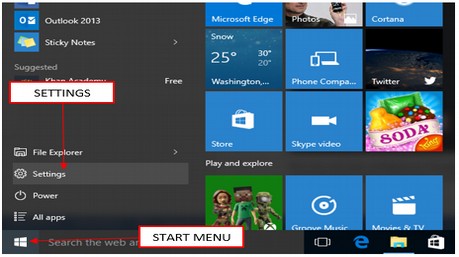
Step 2 − In the Settings window, point to your favorite settings and right-click.
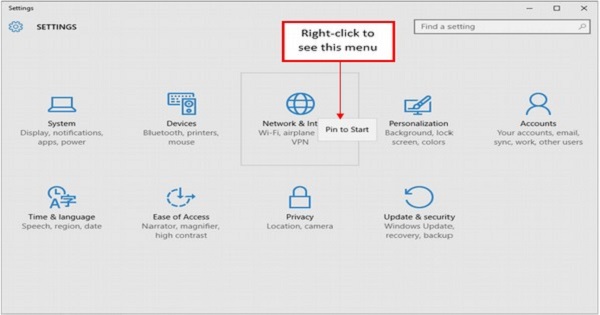
Step 3 − On the small menu that appears, select Pin to Start.
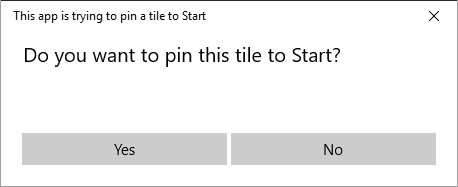
Step 4 − Click Yes on the screen to confirm the action. After this, you will see the Network & Internet app directly in the Start Menu.
You can also pin more specific setting apps. To do this, follow these steps −
Step 1 − Open the Settings window again.

Step 2 − On the SETTINGS window, click on System.
Step 3 − On the SYSTEM window, right-click on Display.
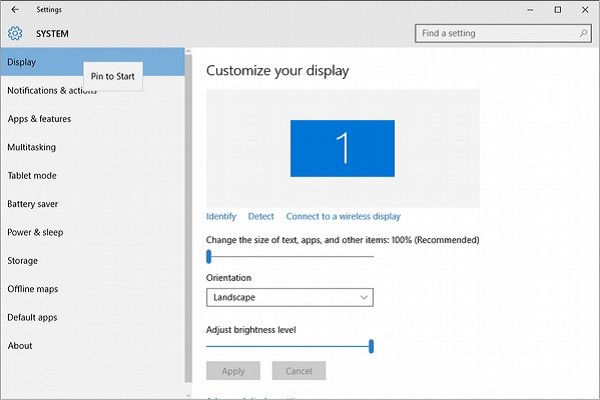
Step 4 − From the small menu, select Pin to Start. Like the previous example, this will pin the Display setting to the Start Menu.

Unpin your Favorite Settings
Alternatively, you can remove any pinned app from the Start Menu just by right-clicking on it and choosing Unpin from Start.
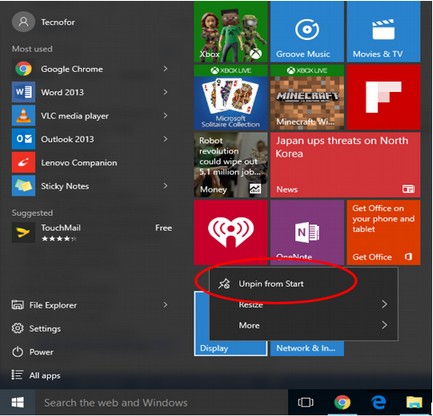
Windows 10 - Shortcuts
In Windows 10, a shortcut is simply an icon that directs you to an item (a document, application, or picture) that is located somewhere else in your computer. As the name implies, shortcuts make it easier for you to access that item by being more accessible (usually on the Desktop). Shortcuts are identified by a small arrow in the corner of the icon.
Creating a Shortcut
To create a shortcut in your Desktop, follow these steps −
Step 1 − Position your mouse pointer over an empty space and right-click.
Step 2 − In the menu, select New and then Shortcut.
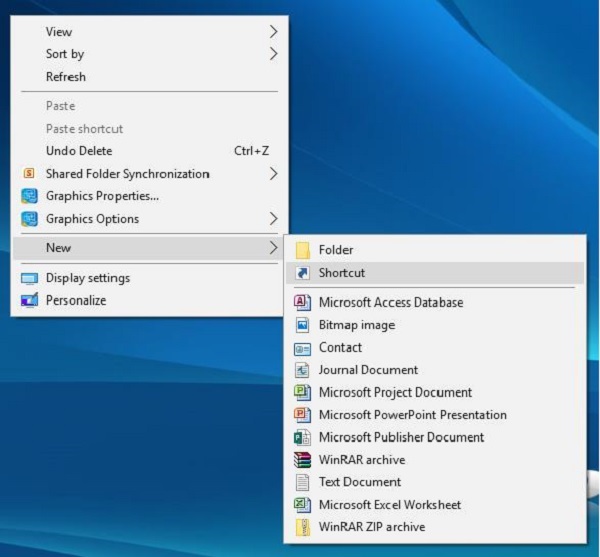
Step 3 − On the Create Shortcut window, you can either Browse or type the location of the item you want to access.
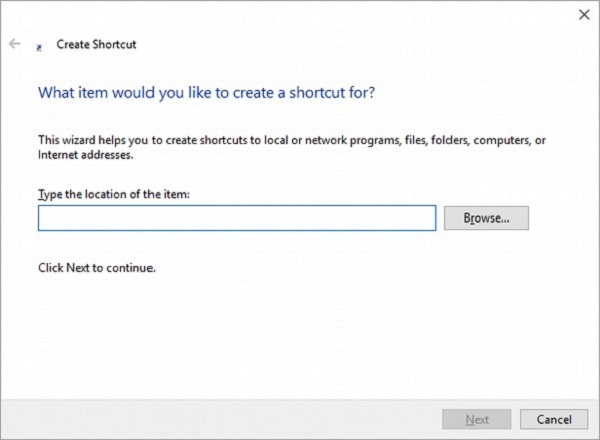
Choosing Browse will open another window, allowing you to search for the item in your computer.
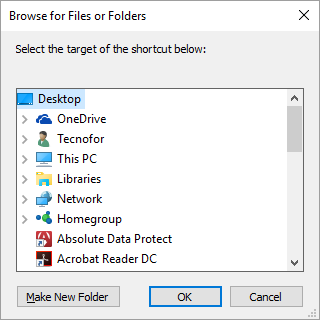
Step 4 − After choosing the item and clicking Next, you can assign or change the name with which the shortcut will be identified.
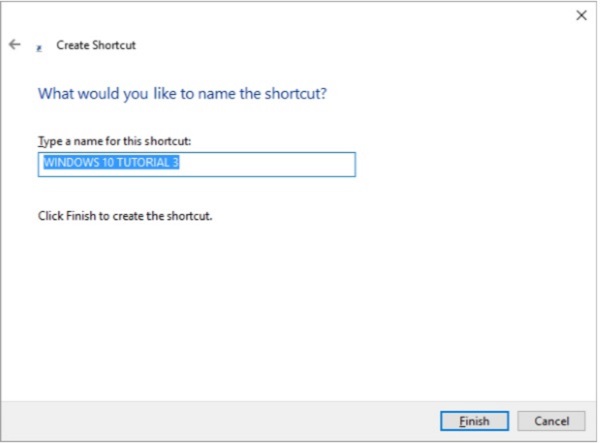
Step 5 − After making any changes, click Finish. You will then see the shortcut in your Desktop.
Deleting the shortcut wont delete the file it accesses.
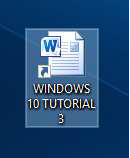
Windows 10 - Phones
Windows Phone 10 is a mobile operating system, marketed by Microsoft as an edition of Windows 10. It is part of Microsofts plan to unify all their platforms under one brand.
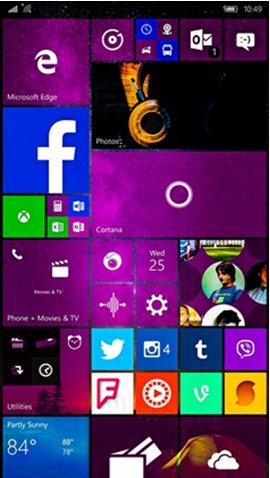
Windows Phone 10 was released in November 2015 and is included in Microsofts smartphones and tablets. It features support of Microsoft Office apps and also lets you synchronize your notifications between multiple devices.
